Germany Day !
The development of ww2 german cruisers started in interwar Germany, restarted in 1933 but cut short by the war, with plan Z postponed and cancelled later. It left the Kriegsmarine with just ten light cruisers and three heavy cruisers just completed, the remainder in completion. This force was certainly not able to turn the tables during the war, and indeed they were lost early on, never giving their full potential as commerce raiders in Raeder’s strategy. This article goes through the whole development of German Cruiser lineage from reserve Reichsmarine vessels to (numerous) Plan Z projects.
WW2 german cruisers general overview: Between pre-WWI Reichsmarine authorized light cruisers to the K class, the Deutschland class, and Kriegsmarine’s heavy cruisers as part of Plan Z, scouts (Spähkreuzer), Minenleger kreuzer and the class D, P and M Panzerschiffe. https://naval-encyclopedia.com/ww2/germany/german-cruisers.php #ww2 #kriegsmarine #germannavy #bremen #hipper #blucher #prinzeugen #deustchland #lutzow #nurnberg #leipzig #grafspee #koenigsberg #koeln #karlsruhe

KMS Prinz Eugen as completed in 1940 (hirootoko jr.)
The inheritance of WW1 cruisers
The Kaiserliches Marine had in 1918 still a plentiful array of cruisers, between old protected cruisers, armoured cruisers (called “schwere kreuzer” or heavy cruisers), and more recent scout (or light) cruisers such as the Köln class. The last and best of them were interned in Scapa Flow, later scuttled in 1919, whereas a number were taken over by countries such as France and Italy as war reparation. In the case of France, no less than four, which soldiered on until 1937.
Battle reports from various engagements saw the validity and confirmation of the role of the cruiser together with lighter units, high seas torpedo boats for screening the main battle fleet, perform minelaying missions, hunting down enemy flotillas, patrol and prey on convoys. It showed also the limitations of armoured cruisers in the battle line (loss of Blücher for example). Battlecruisers seemed more promising in any case. This was confirmed also that armoured cruisers stood little chance even against less armoured capital ships, the battlecruisers that sank the the Scharnhorst class at the Falklands.
The treaty of Versailles fell like an axe of the Kaiser’s proud and affluent navy: Germany would be limited to just six cruisers (six pre-dreadnought battleships, six light cruisers, twelve destroyers, and twelve torpedo boats). This was the rank of a Scandinavian coastal navy like Sweden, and quite an humiliation. The six cruisers in question what were left from war reparations and internement: Essentially 1900 models that were at the root of the previous cruiser lineage: The Gazelle (1898) and Bremen class cruisers (1903).
For the newly created Reichsmarine, the order of the day was to rebuilt at least a defensive fleet based on this, in the hope of replace some of these ships on obsolescence grounds when possible as authorized by the allied commission, and prepare a whole generation of future officers for a possible future expansion.
This is not a surprise when the first new, modern cruiser built for the Reichsmarine was a school cruiser: RMS Emden.
Reichsmarine cruisers

The Reichsmarine in 1935. Note the initial six cruisers of the Gazelle class were reinforced by two more used as school ships (and thus granted not in the total), RMS Berlin and Hamburg from the Bremen class. Since Germany needed cash, the old Niobe (Gazelle class) was sold to the newly formed Kingdom of Yugoslavia as Dalmacija in 1925. Thetis was sold and broken up in 1930, Nymphe in 1932 and used as source of spares for the others. It left only Amazon, Medusa, Arcona, Berlin and Hamburg. The missing sixth cruiser ws indeed a new one: RMS Emden (see later).
Flottenkreuzer (FK1) Entwurf 1916

The case of Flottenkreuzer (Entwurf 1916): This was last project, unbuilt, planned in 1916. If completed, they would have been enlarged Köln(ii) class, but very little informations is available on this design. Likely to have been called the “Aachen class”, its Displacement was to have been 4025 tonnes Normal, 4,850 tonnes Full Load for 131/136 m oa x 12.4 x 4.6 meters and 7.85 meters in Side Height, carrying 5×1 15cm (5.9″)/45 SK L/45 main guns, two 8.8cm (3.46″)/45 SK L/45 AA guns, and four single deck 60cm TT (H8 Torpedo) plus rails for 100 Mines.
Armor was 40mm at the Belt max, 30mm on Turtleback and 15-30-15mm flat for the Armored Deck, 30mm for the Citadel, 80mm for the CT, 50mm for the Gun Shields, 30mm for the Rangefinder and powered by two steam turbines with 3.5 m screwss fed by five Double-Ended Oil-Firing Boilers (18 atm/264.5 PSI) 52,000 SHP Forced and estimated 33 knots, aslo Forced heat.
With 1150 tonnes this gave her 5,185 km (2800 nautical miles) at 17 knots on paper and she was crewed by 356 (15 officers/341 sailors).
src1 src 2. She was an interesting step as her design became the basis for the new KMS Emden in 1924.
Interim Cruisers: Gazelle class (1900)
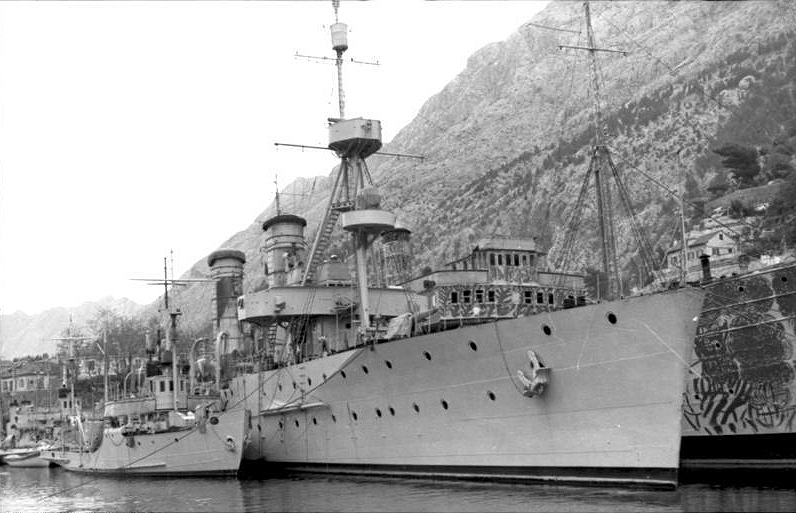
KMS Niobe in Yugoslavian service as Dalmacija in Kotor harbour, 1941.
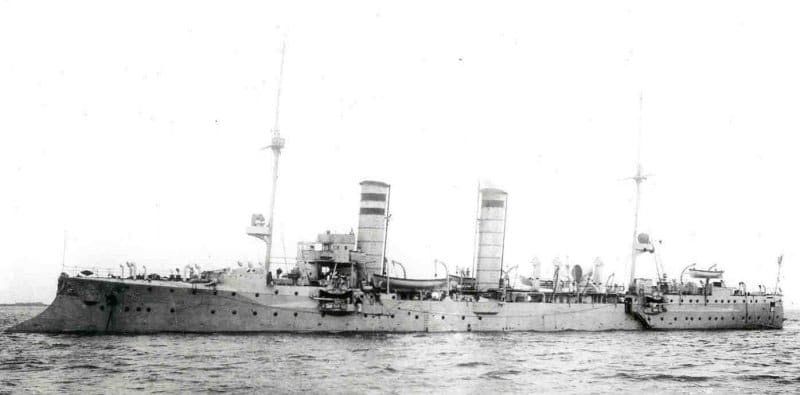
Gazelle appearance in 1914
 KMS Niobe (later Dalmacija)
KMS Niobe (later Dalmacija)
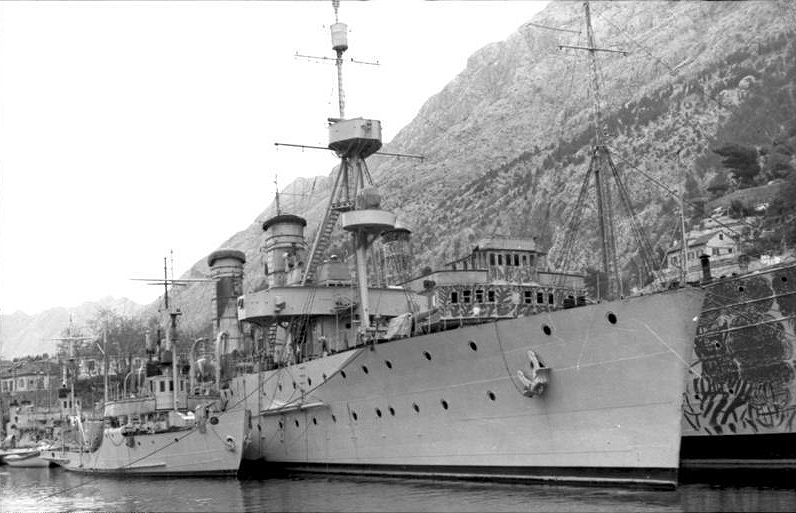
The Kingdom of Serbs, Croats and Slovenes initially received by treaty former Austro-Hungarian Navy vessels after the dissolution of the Austro-Hungarian Empire. But the Allied powers seized the majority of these, allocated them notably to France and Britain. Left with only twelve modern torpedo boats, Yugoslavia wanted at least a lead ship, a more powerful vessel. When the occasion arose through intermediaries, a commission purchased the old Niobe when Germany placed her for sale in 1925.
As Germany was forbidden from exporting armed warships she was disarmed in the Deutsche Werke shipyard prior to transfer, inclusding the removal of some armor, and her conning tower. But she was also modernized, notably having a new clipper bow, and her radio modernized. On 7 August 1926, she started sea trials and was officially transferred, taken to the Tivat arsenal (Kotor Bay) on 3 September 1927 to be renamed Dalmacija (Dalmatia), received her new intended armament.
In Royal Yugoslav Navy service and according to Conway’s All the World’s Fighting Ships, she had six Škoda 8.5 cm (3.35 in) L/55 quick-firing guns on deck, presumably one fore and aft, the rest on the broadside, and initially four, later six 2 cm (0.79 in) anti-aircraft guns. Naval historian esteemed her main battery had 8.6 cm (3.4 in) dual-purpose guns instead (either Škoda or Bofors), and was completed by four 20 mm Swiss Oerlikon single-mount AA guns. Naval historian Milan Vego said this was more likely six 8.3 cm (3.27 in) L/35 AA guns and four Škoda 47 mm (1.9 in) guns back by six machine guns. Aidan Dodson concurs correct this by precising these were 55-caliber Skoda M27 type, not AA guns, and added that she also carried two 15 mm (0.59 in) Zbrojovka ZB-60 AA machine-guns.
Dalmacija was used as a gunnery training ship and by May-June 1929, with the submarines Hrabri and Nebojša sortied with the the submarine tender Hvar and six torpedo boats to Malta, the first of such cruisers by the Royal Yugoslavian Navy, then visited Corfu and Bizerte. According to the British naval attaché, they made an overall very good impression in Malta. In 1930, the cruiser saw her foremast modified, with supporting struts making it a tripod. Dalmacija made several more training cruises in the Mediterranean while being the Navy’s flagship.
When WW2 broke out however she was mobilized despite her age, as a training ship, anchored in Kotor until the invasion of April 1941. Anchored as a defense vessel, she provided a decent heavy anti-aircraft protection to the port as she was. Following the Yugoslav surrender, she was captured by the Italians on 25 April, renamed Cattaro, and returned in limited service with the Regia Marina, as a gunboat and gunnery training ship, moved in Pola. On 31 July 1942, she was torpedoes while underway during a training cruiser, by the submarine HMS Traveller, south of Premantura (Istrian coast) but missed.
Her fate is somewhat foggy, and either she was transferred to the Independent State of Croatia,becoming its main training ship as Znaim. Or returned to German service in September 1943, staying in the Adriatic Seamanned by a mixed German and Croatian crew as KMS Niobe. According to Twardowski she was Italian, then Croatian and renamed Damatia, whereas Aidan Dodson states she was under boiler repairs at Pola when falling into German hands.
At least the latter noted its armament at the time: Six 8.4 cm (3.3 in) AA guns, four 47 mm AA guns, four 20 mm Oerlikon AA guns, twenty-six 20 mm Breda AA guns. For Navypedia, she was rearmed in September 1943, with a 2,360/2,953t displacement, 104.4m long, 12m wide, 5.20m draught, 16kts, six single 84/55 Škoda M.27, six single 20mm/65 C/38 guns. She was recommissioned on 8 November and refitting on 21/22 September when attacked by the two British Motor Torpedo Boats MTB 226 and MTB 228 northwest of Zara, but missed. KMS Niobe escorted convoys through the Adriatic from 13 November 1944 (Operation Herbstgewitter) with the 71st Infantry Division to Cres, Krk, and Lussino.
On 19 December 1944, 18:00, she ran aground on the Silba island due to navigational error. The ship was stuck and soon spotted by local Partisans that informed the British, and three days later, MTB 276 and MTB 298 attacked her. Static, she was an easy prey, both hit with her torpedoes, as well as the tug Parenzo moored alongside. In all, 19 crewmen were killed and the Germans abandoned the wreck, some staying behind to sabotage or carry out weaponry and sensible equipment, then blasted out the ship. She was later cannibalized for spare parts by the Partisans and her remains stayed on Silba until 1947, raised and broken in 1952.
 KMS Nymphe
KMS Nymphe
KMS Nymphe was among the six light cruisers permitted by the Versailles commission to be retained. She was in Wilhelmshaven by 4 November 1920 and by November 1922 to early 1924, modernized at Deutsche Werke: Original ram bow replaced with modern clipper bow (overall length 108.7 m or 357 ft), new mast, new battery of 10.5 cm SK L/45 guns, all in compact U-boat mountings. She also had two 50 cm (20 in) torpedo tubes, deck-mounted. Recommissioned on 30 November 1924 she underwent sea trials under command of KzS Ernst Bindseil and even became flagship of light Naval Forces, Baltic Sea on 18 December (Konteradmiral Iwan Oldekop). Next under FK Georg Kleine in January 1925 she underwent routine training exercises but also cruised in Norwegian waters, visiting Merok (25-30 June).
By 1926 she made a major training cruise from the Atlantic to the Mediterranean, stopping in Cadiz 20-24 May, Mahón, Menorca 27-29 May, Málaga 1-8 June, Vigo 12-13 June and back home for the summer fleet maneuvers. 4-5 September saw her in Skagen, Denmark (new commander FK Fritz Conrad after Kleine, and then KzS Wilfried von Loewenfeld in March 1927). She made another Atlantic cruiser and port call, was however in the Bay of Biscay when caught by severe weather (winds 10–12 Beaufort scale) and was repaired at El Ferrol 2-14 April. She visited Santa Cruz 17-20 April, La Luz (Málaga) 24 April-2 May, Lanzarote (Canary) 3-9 May, Horta, Ponta Delgada (Azores, 14-23 May, 24- 29 May) and Seville 3-7 June, Cadiz 7-8 June and summer fleet maneuvers when back.
1928 saw her in a fleet cruise to Norway by July 1928 after a short refit, stoppping at Bergen and Ulvik. By September, FK Wolf von Trotha took command (her last) and on 15 October, KAdm Walter Gladisch but the cruiser was only active for six months, decommissioned on 16 April 1929, in Kiel, replaced by the new light cruiser Königsberg. She shortly became a barracks ship until 31 March 1931, stricken, sold on 29 August, BU in Hamburg.
 KMS Thetis
KMS Thetis
KMS Thetis was another cruiser authorized by the Treaty of Versailles and she was modernized in the early 1920s in the same way as her sisters. Recommissioned on 2 April 1922 she was assigned to the Marinestation der Ostsee or Baltic Sea Naval Station under FK Walther Kinzel. After 1922 routine training exercises the next year saw her in overseas cruises, to Mölle, Sweden, 11-15 July and Loen 18-24 July. In October KzS Ernst Bindseil took command as the fleet was reorganized, Thetis being promoted to flagship of light naval forces, Baltic, with KMS Medusa and the I Torpedo-boat Flotilla under Kommodore Iwan Oldekop, later konteradmiral.
Thetis in July 1924 visited Estonia, Tallinn 5-10 and Pärnu 12-14 July. On 30 November she was decommissioned in Wilhelmshaven, replaced by KMS Nymphe. She became a barracks ship in Wilhelmshaven until early 1929, stricken on 27 March, sold to Blohm & Voss, BU in Hamburg, 1930.
 KMS Amazone
KMS Amazone
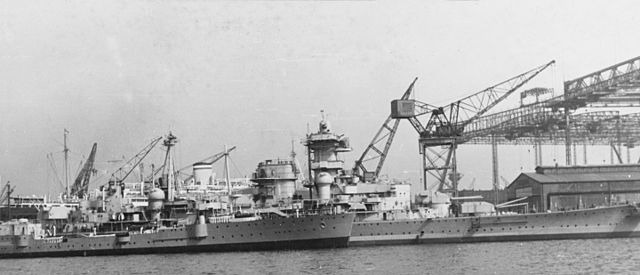
KMS Amazon and Admiral Hipper at Blohm and Voss shipyards, 1939
Part of the authorized six light cruisers, Amazone was modernized, rearmed at the Reichsmarine Werft, Wilhelmshaven in 1921-1923 (clipper bow, ten 10.5 cm SK L/45 guns in U-boat mountings, two 50 cm (20 in) deck launchers) recommissioned on 1 December 1923 under KzS Walter Gladisch, replacing KMS Arcona as flagship, light forces, Marinestation der Nordsee with the light cruiser Hamburg, II. Torpedo-boat Flotilla. 1924 was spent in exercises and visits abroad, notably Bodø in Norway.
In March 1925, KzS Eduard Eichel took command and the routine resumed, she visited Rotterdam, and trained in the Eidangerfjord, Norway in June-July. May-June 1926 saw her in the Mediterranean, and by September FK Alfred Saalwächter took command. In 1927 she made a major cruiser in the Atlantic 28 March-16 June and by September FK Albrecht Meißner took command. She visited Norway on mid-1928 with the battleship Schlesien, stopping at Molde and Merok and was in manoeuvers at Skagen, Denmark. She stayed in the baltic by 1929 making a single trip to Gothenburg, Sweden by August.
After the Reichsmarine reorganization on 1 January 1930 Amazone from the Reconnaissance Forces Command (Counter-Admiral KAdm Gladisch) she was decommissioned in Wilhelmshaven on 15 January, used as barracks ship, stricken on 31 March 1931 but not BU. Instead she assigned to the Submarine Acceptance Commission in Kiel. She became an auxiliary for the Warship Construction Test Office. After 1939 she was towed to Bremen, and keep her role as accommodation hulk after 1945 for refugees from eastern Europe. In 1954, plans to convert her into a floating youth center did not succeed and she was BU at last in Hamburg.
 KMS Medusa
KMS Medusa
SMS Medusa was among the light cruisers the new German Navy permitted to retain as per Treaty conditions. She was used by the Reichsmarine when clearing minefields laid in the North Sea, converted into a mother ship for the planned 12th Minesweeper Half-Flotilla, which was never created in the end. Instead, she was recommissioned on 17 July 1920 (FK Alexander Werth in command) as the first major warship commissioned of this new postwar navy. She was assigned to Marinestation der Ostsee, as lead ship for two Baltic sea torpedo boat flotillas and the survey ship Triton. She carried President Friedrich Ebert on a trip to East Prussia, visited foreign ports until 5 September 1920, notably Fårösund, Visby on Gotland.
On 10 February 1921, the battleship Hannover, recommissioned relieved Medusa as the fleet’s flagship. With the torpedo boat flotillas conducted the first annual fleet training exercises this summer 1921, in the western Baltic. Medusa visited also ports in the Baltic until 2 August such as Uddevalla and Gothenburg in Sweden and operated in the fall of winter, as an icebreaker in the Gulf of Riga until 12 February 1922, and visited Windau in Latvia but had to be overhauled and repaired when back home. In the next summer, after fleet training, she cruised to Gävle in Sweden (22-26 June), then Finland (29 June-3 July) and in September, had a new captain, KK Ernst Meusel, also her last commanding officer. Back to Gothenburg on 11-15 July 1923 she commanded the I Half-Flotilla in a new cruise to Molde and Åndalsnes in Norway. In October 1923, the reorganizion had her replaced by a battleship and she became part of the light naval force. In July 1924, she visited Gävle and when back on 26 September, decommissioned.
On 1 February 1928, she became a barracks ship, for torpedo boat and destroyer crews, anchored in Wilhelmshaven. On 29 March 1929, she was stricken and continued her career as an unnamed barrack ship until WW2 broke out. In July 1940, she was converted into a floating FLAK (AA) battery, at the Rickmers Reederei shipyard, Bremerhaven, under her old name, KMS Medusa.
Flakschiffe KMS Medusa
Completely rebuilt, she had in her new configuration one 10.5 cm SK C/32 gun, four 10.5 cm SK C/33 guns, two 3.7 cm (1.5 in) SK C/30 guns, four single 2 cm/65 C/38 (0.79 in) Flak guns.
Full displacement was now 3,100t, and machinery was removed entirely.
Assigned to Naval Anti-aircraft Group 222, she protected the port of Wilhelmshaven, anchored off Varel from 13 August 1940.
In 1944 – 1945, Arcona and Medusa sw the removal of one 37mm/80, two 20mm/65 but the addition of two single 40mm/56 FlaK 28, a Flekvierling (quad) 20mm/65 C/38, and a FuMO 212 or FuMO 213 radars.
On 19 April 1945 an Allied air attack targeted her. Bombs and near-misses killed 23, wounding 41 of her crew while she was crippled, but stayed afloat, more wreck than ship. She was therefore scuttled on 3 May, a few days befoe the end of the war. What was left was examined by British occupation troops, and estimated she was a danger so close to the Wiesbaden Bridge. Her wreck was salvaged in 1948–1950 and BU.
 KMS Arcona
KMS Arcona
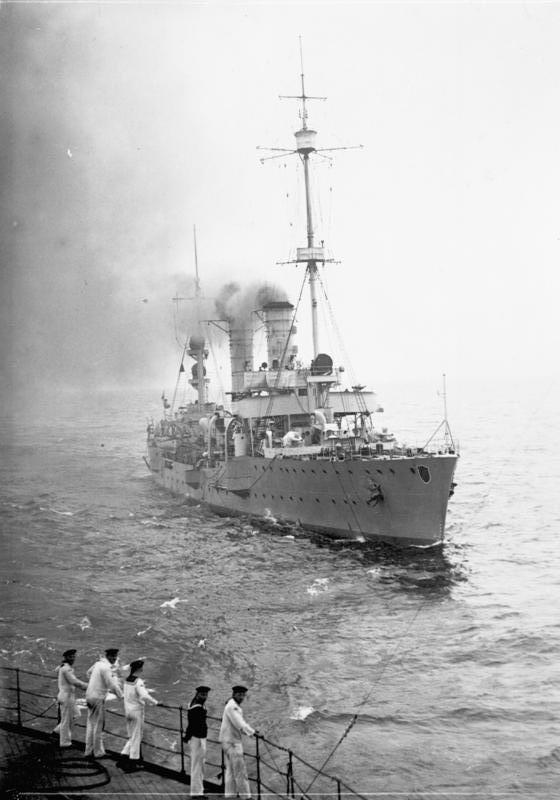
Arcona as minesweeper Mothership 1919-1920
Arcona was not authorized by the Versailles treaty it seems, not she was in clear service. Since Germany was responsible for clearing mines in the North Sea, Arcona was selected in early 1919 to be a mother ship for minesweepers (The pre-dreadnought battleship Preussen was deemed unsuited). She was modified at the Reichsmarine Werft (former Kaiserliche Werft) in Wilhelmshaven keeping only her stern guns, to detonate mines encountered, and modernized communication set plus extra accomodations. Kapitänleutnant Erich Haeker took command by May 1919 and she was then assigned to support V Minesweeping Flotilla until February 1920. She was then decommissioned for a full modernization and more effective fleet service.
As Marinestation cruiser 1921-1939
She received the same modifications as the other Gazelle class (new bow, new guns, new TTs) and by 25 May 1921, recommissioned, assigned to the Marinestation der Nordsee (KAdm Konrad Mommsen), under command of FK Friedrich Hermann. She visited Arendal, Sandefjord (Norway) this summer as Frederikshav (Denmark) for the inauguration of a monument to German sailors who had died in the Battle of Jutland. She returned in drydock to have her clipper bow reinforced and mofified as to serve as an auxiliary icebreaker by February 1922, for the western Baltic and Kattegat, Gulf of Riga. While there she received ice damage, and had to retire, replaced by the battleship Hessen, being repaired later. By mid-1922, she visited Balestrand in Norway, and by 1923 Åbo in Finland, Karlskrona in Sweden and this summer KzS Walter Gladisch took command. She was decommissioned eventually on 1 December 1923, replaced by Amazone. Nevertheless she stayed other utility tasks for 7 years before stricken on 15 January 1930: Barracks ship in Wilhelmshaven, Swinemünde (1936) Kiel (1938) and until September 1939.
Flakschiffe KMS Arcona
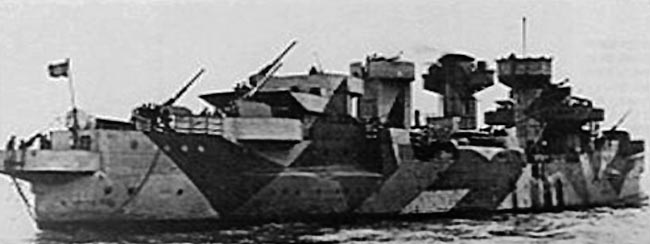
Flakschiffe Arcona in WW2
In May 1940 she was towed for conversion as floating anti-aircraft battery in Swinemünde:
1x 10.5 cm SK C/32 gun,
4x 10.5 cm SK C/33 guns
2x 3.7 cm SK C/30 guns
1×4 2 cm guns, but also rebuild superstructures, new bridge, new FCS, larger AA light projectors. No care was given to their powerplant, and possibly part was removed for more accomodation and ammunitions storage.
Towed to Wilhelmshaven, she was assigned to Naval Anti-Aircraft Group 233, and later at Brunsbüttel. In 1945 she was scuttled to prevent capture on 3 May. She was nevertheless discovered when the RN took control of Brunsbüttel on 7 May. Seized with four U-boats and Z31 they had their ammunition unloeaded, weapons removed and she was BU in 1948–1949.
Bremen class (1903)
None of these were active in WW2, but some served in the interwar.
 KMS Berlin (1900)
KMS Berlin (1900)
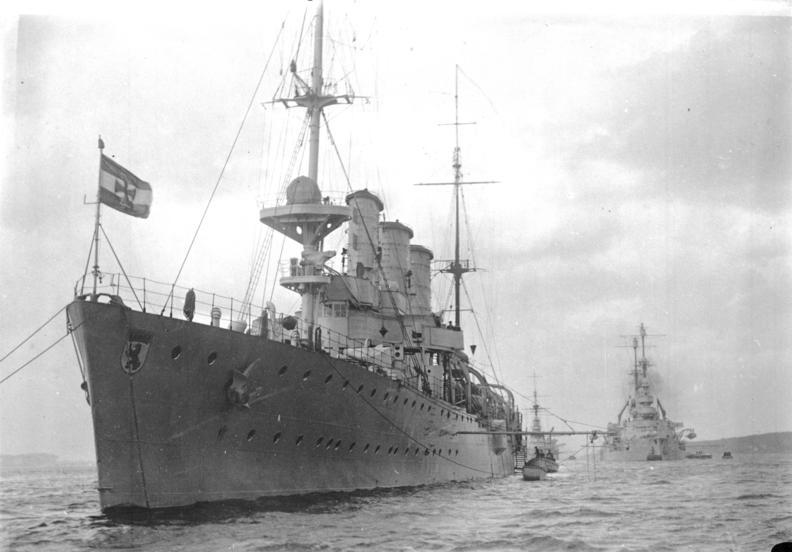
Berlin was among the six light cruisers authorized as per the Treaty of Versailles in 1919, initially a training hulk for boiler room crews in Kiel starting on 16 December 1919 under Oberleutnant zur See (First Lieutenant) Clamor von Trotha (December 1920-April 1921) and KL Hans Walther. However the Reichsmarine allocated funds to modernize her and take a more active service. A modernization and adaptation as a training ship for naval cadets started at Wilhelmshaven, decommissioned on 10 June. The modifications resembled previous cruisers: Clipper bow, new guns, new communication set, partly rebuilt bridge, and new accomodations for cadets. She was recommissioned on 2 July 1922 under KzS Wilfried von Loewenfeld, joining the Naval Training Inspectorate.She made the first of many training cruises, the first in Scandinavian waters and Netherlands, and the newt year, Norway, Iceland, the Faroe Islands. By October 1923, KzS Paul Wülfing von Ditten took command.
On 15 January 1924 she made the longest overseas cruise so far, going to mid-Atlantic, Azores (Ponta Delgada) and when back Santa Cruz de Tenerife, Las Palmas (Canary Islands), Funchal and Cartagena in Spain, then back to Kiel on 18 March. Then summer fleet maneuvers, Reichswehr ministed Otto Gessler. On 1 November she made another longer cruiser to Central and South America. She stopped along the way in the Azroes, Saint Thomas, U.S. Virgin Islands, Cartagena, Veracruz, Havana, La Guaira, San Juan, Puerto Rico, and Ponta Delgada when back. She was damaged by a severe storm in the Bay of Biscay but arrived in Kiel on 16 March 1925. By July she changed captains for KzS Ernst Junkermann.
She departed on the next 9 September for the western coast of South America (Ponta Delgada, Hamilton, Port au Prince, Colón, Puerto Madryn, Argentina, Guayaquil, Callao, then Valparaiso, Corral, Talcahuano, Punta Arenas, Mar del Plata, Buenos Aires, Montevideo, Rio de Janeiro and back via Vigo, Kiel on 22 March 1926. On 25 September however her role as training ships was taken over by the new light cruiser Emden and her crew was reduced., under FK Hans Kolbe. Transferred from the Naval Training Inspectorate, Marinestation der Ostsee she made another cruise to the central Atlantic in April-June 1927, stopping in the Azores, Portugal and Spain.
Fleet maneuvers and a naval review for President Paul von Hindenburg on 14 September from the battleship Schleswig-Holstein. The latter moved to Berlin to be carried to Königsberg. After kMS Hamburg was decommissioned, Berlin was reassigned to the Naval Training Inspectorate on 1 October and started a last cruiser on 1 December, for 15 months to East Asia, making many port calls and stopping at Fremantle in Australia. Back in Cuxhaven on 7 March 1929, then Kiel, she was decommissioned on 27 March, placed in reserve until 1 October 1935, stricken, barracks ship in Kiel until 1945. Postwar she was loaded with chemical weapons, scuttled in the Skaggerak on 31 May 1947.
 KMS Hamburg (1900)
KMS Hamburg (1900)
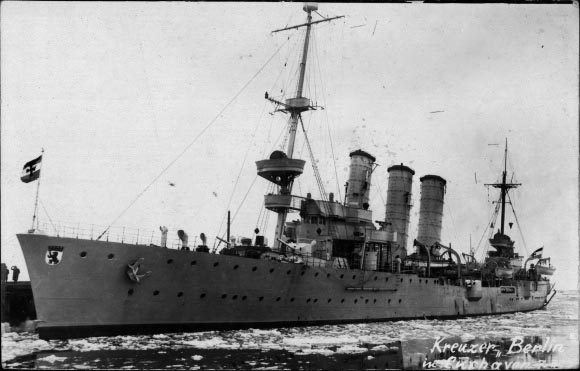
Another photo of KMS Berlin. Unfortunately no photo exist to my knowledge of Hamburg in the interwar.
SMS Hamburg was devoid of crew and unable of service in 1920. Instability drawn its sailors in arms during the Revolution of 1918–1919. Under the Reichsmarine, all ships permitted under the Versailles Treaty were made ready, and Hamburg was selected, recommissioned on 7 September under FK Bernhard Bobsien, Marinestation der Nordsee as flagship under KAdm Friedrich Richter and later Walter Hildebrand, managing the II, IV, and VI Flotillas tasked of clearing minefields. Later the unit was commanded by KAdm Konrad Mommsen from 2 April 1921 and she stayed a flagship. She made a visit to the Shetland Islands 13-17 June, a first foreign visit of any German warship.
By July 1921, SMS Hamburg took part in fleet training exercises with Hannover and Medusa, I and II Flotillas. She escorted minesweepers (8th-11th Minesweeper Half-Flotillas) clearing another minefield. In Kola Bay however she was targeted by a Soviet coastal battery and the captain ordered to return fire before leaving the area. This was one quite an inciden, reflecting the attitude of the Bolsheviks towards the Germans at this stage. The cruiser after her mission visited Vardø, Hammerfest, Tromsø, Ålesund and Bergen, back to Wilhelmshaven on 31 August. By February 1922 she became an auxiliary icebreaker in the Baltic but her weak hull sent her in drydock for repair. Replaced as flagship by the battleship Braunschweig she spent the rest of 1922 visiting Odda and summer fleet maneuvers, plus FK Erich Heyden taking command.
In July 1923 she visited Hanko in Finland, Rønne on Bornholm however unrest in Weimar forced her in by October with her escort torpedo boats detached to the Harburg district while Hamburg sent a landing party ashore to help the police. After 15 October an Oberbefehlshaber der Seestreitkräfte was created to manage the two Marinestation and Hamburg became flagship for KzS Adolf Pfeiffer, North Sea. 1924 saw a routine of exercises, visit to Riga and summer maneuvers, then change of captain (KzS Lützow), and commander (KAdm Erich Raeder) and Franz Wieting in January 1925. Hamburg was transferred to Marinestation der Ostsee, Kiel. By May, KzS Ernst Junkermann took command, then KzS Paul Wülfing von Ditten, KK Hermann Densch.
She was assigned to the Training Inspectorate as training ship under FK Otto Groos and prepared for a circumnavigaion cruiser. Carl Wilhelm Petersen (mayor of Hamburg) presented his city flag to the cruiser on 14 February 1926 and embarked to Cuxhaven. Hamburg sailed to the Atlantic, stopped at Pontevedra (Spain) Funchal (Portugal) Las Palmas (Canary), reached the West Indies, passed the Panama Canal, visited North and Central America (stayed a while in San Francisco) then sailed to the Pacific Ocean, Honolulu and Japan, the Philippines (Manila, Iloilo City), Java ion the Dutch East Indies, Indian Ocean (Colombo), Red Sea, Suez Canal, Mediterranean, Vigo and back in Wilhelmshaven on 20 February 1927.
This was also her farewell tour. She was decommissioned on 30 June 1927, reserve in 1928, stricken on 31 March 1931, then converted as barracks ship for submarine crews in 1936, in Kiel until 1944, then towed to Hamburg 7 July 1944 for scrapping when sunk by British bombers on 27 July, raised in 1949 and BU in 1956.
New built cruisers (1925-1939)
This was a grdual affair. After having modernized many 1900 cruisers of the Gazelle and Bremen class as seen above, most were gradually decommissioned as the Reichsmarine planned new classes. This was perfectly authorized by the Versailles treaty commission to naval affair to replace ageing exiting ships by new ones.
Rebuilding Shipyard skills: Emden
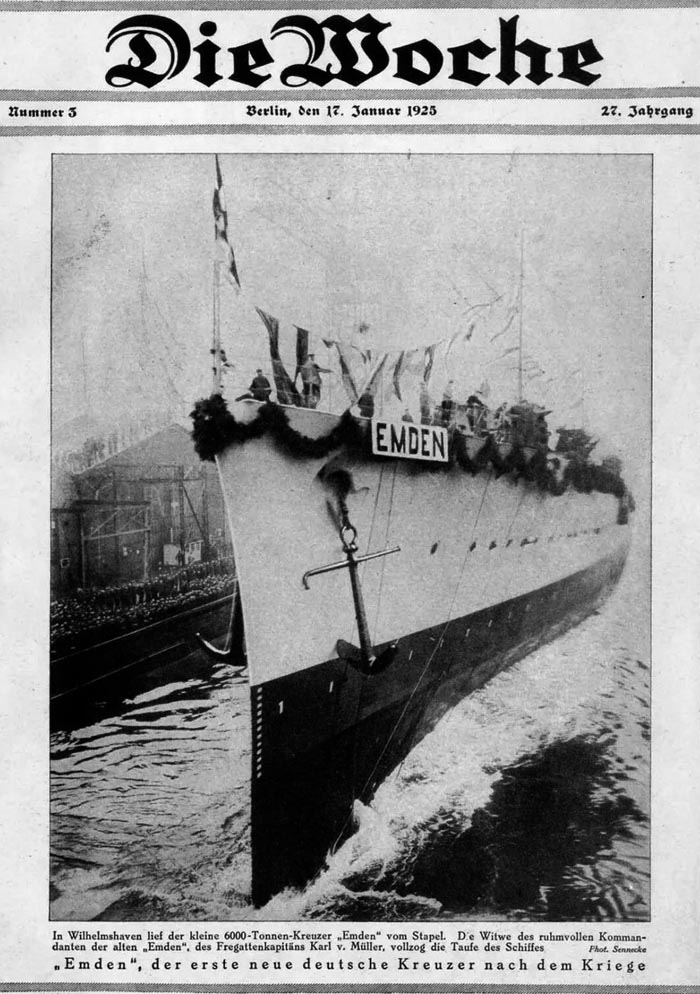
The launch of KMS Emden, die Woche, January 1925 in Wilhelsmhaven.
Thus, the Reichsmarine started a program of modernization in the 1920s including for a start, a new cruiser based on latest WW1 design to just rebuilt its shipyard’s skills: Emden. Afterwards, was planned the “K” class (after the three namesake cities, Königsberg, Karlsruhe, and Köln). They were a bold step forward, not only with a new armament in triple turret (skipping the twin turret step entirely), and also try a new construction technique, welding instead of riveting to save weight. Not only for performances, but also overall tonnage savings under the commission’s auspices. There an interesting point to make here. It’s the Versailles treaty which framed the new Reichsmarine, not the Washington treaty after 1923, but the treaty which forbade new battleships (six former ones authorized), said nothing about cruisers, but announced a general limit of 10,000 tonnes and a number: 6. This means the new Weimar republic was perfectly in its right to decommission these antiquated cruiser and replaced them for new ones.
German light cruisers 1926-1936
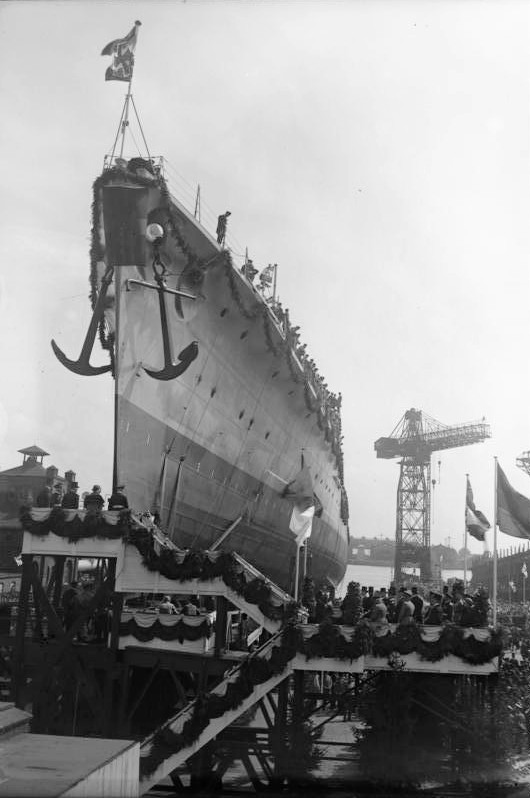
The launch of Köln at Wilhelsmhaven
Thus the new Könisgberg class was planned and announced as intended to replace previous Gazelle-Bremen class vessels. German engineers for these ones tried to stay well within the Versailles Treaty limitation, while departing at the same time completely from the Emden design. The great novelty in these turrets maximizing firepower at all angles was added to a quirkcy arrangement, with one forward, axial and two aft, in echelon arrangement, which was never seen before for that class of ships (or since).
In 1924, the imposed limited displacement limited protection, armament, so only speed was left to play with. As a result, these cruisers were marked by a very, very light construction thanks to the all-welded hulls, but leaving her with sketchy longitudinal strength, even taking the light superstructures in account. Their L/B ratio exceeded 11:1 on plans. They were essentially enlarged destroyers but registed when trialled an abnormal torsion, and durability issues resulting in poor seaworthiness.
They were followed in the late 1920s and to 1935 by two larger light cruisers with enlarged designs but the same, improved formula, KMS Leipzig and Nürnberg. They are detailed below.
Overall, these early cruisers were not that successful, tok heavy losses, but played their part in Norway and afterwards. Only two survived in Norway by 1943.
Weimar’s trick: The “pocket battleships”
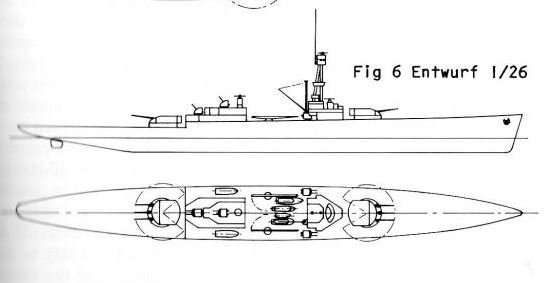
Entwurf Design I/M26, alternative proposal for the Panzerschiffe
The new regime had grand plans after 1933 for new cruisers, light and heavy, even intermediate corsairs like the Deutschland class, which remained the most audacious endeavour of the Weimar Republic, it’s major asset in a new war with France: The Deustchland class.
The latter were planned not as a replacement for the pre-dreadnpoughts as it was forbidden, but simply as “cruisers”, with a catch, as nothing prevented Germany a caliber above 28 cm it was assumed by the allied commission not design was realistically possible with these guns on no more than 10,000 tonnes standard. At best, short coastal ships a la Sverige (and even reduced) were possible.

Entwurf-3-b, possible successor of the Deutschland class, Similar but with larger displacement, higher speed and better Armor, up to 220mm for the armor belt.
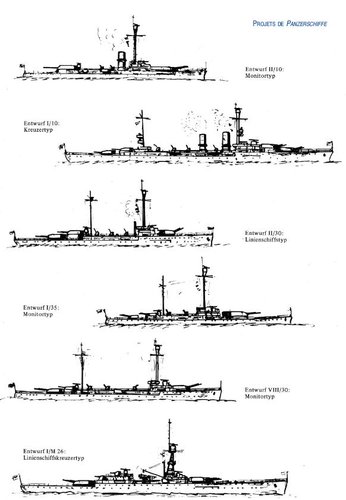 Admiral Zenker, probably the most influencial figure of the Reichsmarine by then, thus planned to built three cruisers armed with 28 cm guns, a caliber well known by pre-WWI german yards, and yet, upgraded, with new fire control systems, and engineers had the daunting task of fitting them on a “light” cruiser no more than 10k tons.
Admiral Zenker, probably the most influencial figure of the Reichsmarine by then, thus planned to built three cruisers armed with 28 cm guns, a caliber well known by pre-WWI german yards, and yet, upgraded, with new fire control systems, and engineers had the daunting task of fitting them on a “light” cruiser no more than 10k tons.
The process started in 1926, with a serie of designs examined, each with variations in 28cm guns turrets, twin and triple.
There were delayed due to elections and strong opposition before 1928. Social Democrats campaigned with “Food not Panzerkreuzer”. Since it was public, the allied commission tried to stop their construction, fearing, rightly so these vessels, faster that they could not fight, stronger that could catch them, were the perfect commerce raiders. It was a dissuading class of ships, but also relaunched an arms race in Europe, the French building its Dunkirk class, the Italian planning the Littorio class later. The Reichsmarine in between offered to the allies to comply to the Washington Treaty with a ratio of 125,000 long tons compared to UK’s 525,000 long tons (533,000 t). UK accepted, twisting France’s arm. Of course this was later revised with the anglo-german agreement of 1935, a naval treaty giving far more leeway to Germany, now free to built the Scharnhost class battlecruisers and later Bismark class capital ships, but also giving some room for its new heavy cruisers (see later).
Kriegsmarine’s heavy cruisers
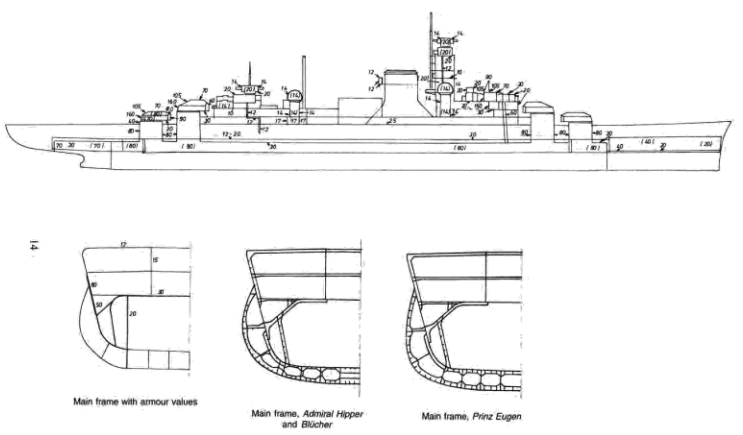
The next step was a first heavy cruiser, a category which already existed (pre-1906 “schwere kreuzer” were in reality armoured cruisers) but this time, the admiralty wanted to go for a first intermediate design with four twin turrets, and from 1933 Admiral Raeder envisioned various options to work like a 7,000 tonnes design featuring single shielded 8-in guns based on a lightly enlarge Leipzig. Indeed since the Versailles treaty still applied, the 6,000 tons standard tonnage was the limit for any cruiser, but in possession by 1919. In 1933 the situation however remains the same on this chapter, even after the breach and compromise found with the Deutschland class.
But it’s really the Anglo-German Treaty of 1935 which completely unlocked the tonnage limit. It gave the newly established Kriegsmarine a 35% tonnage to the RN, and authorized a levelling up to the Washington treaty, so 10,000 tonnes cruisers, but with a catch: Not before 1943. This of course was quickly brushed aside by Hitler, albeit unofficiaously. The keel of KMS Hipper was promptly laid down, at the end of 1935, with hopes to built five based on a calculated 50,000 long tons of heavy cruisers.
In addition the “10,000 tonnes standard” would be announced publicly in paperwork and grossly underestimated. In fact the second pair (Prinz Eugen) fully loaded was close to 20,000 tons…
They were built, like the Bismark class designed at the time, like superior to any compeition, fast with an hybrid powerplant using diesels for long range (as commerce raiders again), but for their large displacement “only” four twin turrets with 8-in guns, but a comfortable secondary and AA armament, torpedo tubes, floatplanes and state of the art fire control systems and radars.
PLAN Z planned “only” five (two “prototypes”, Hipper and Blücher) and three serial, larger (Prinz Eugen, Seydlitz, Lützow). They were all supposed to wage commerce raiding on their own, but had only marginal superiority over their competitors. In an encounter with a County class, they still could count on their artillery range (37° in max elevation for 33,540 m or 110,040 ft range), better than the 8-in BL MK VIII (28,000m or 17 miles) at least on paper. The situation happened when Prinz Eugen duelled at long range with Dorsetshire in May 1941.
The story doesn’t stop here. See below for projects.
 KMS Emden (1925)
KMS Emden (1925)
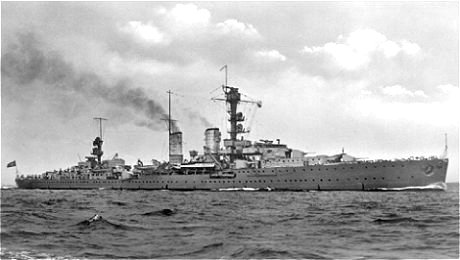
KMS Emden (official) 1935
First postwar cruiser in Germany, the Emden (from the city, also to honor the famous 1914 corsair cruiser), she was authorized in 1921 in an unfavorable economic environment and watchful eyes of the allies commission. Starting with the last known design, she was directly modeled after the last class cruisers of the great war, the “Königsberg II” class. Configuration of the main armament (single shielded 6-in guns) was not of the highest standard compared to those to be developed, but the Reichsmarine was forbidden to study more modern turrets.
After commission of the first Köln class ship, Emden, from active cruiser was reclassified as cadet training ship. Under the command of Karl Doenitz, she took part in several international cruises. With the outbreak of war, she actively participated in operations in Norway (Operation Weserübung), without notable action, and spent the rest of her career in the Baltic, training Sea Cadets. In 1945 she took part in the evacuation of civilians and troops from East Prussia trapped by Soviet Forces, and later brought troops from Norway. She also carried the remains of Marshal Hindenburg. Badly damaged in April 1945 by the RAF, she was scuttled at Heikendorfer Bucht and dismantled after the war.
 K class (1927)
K class (1927)
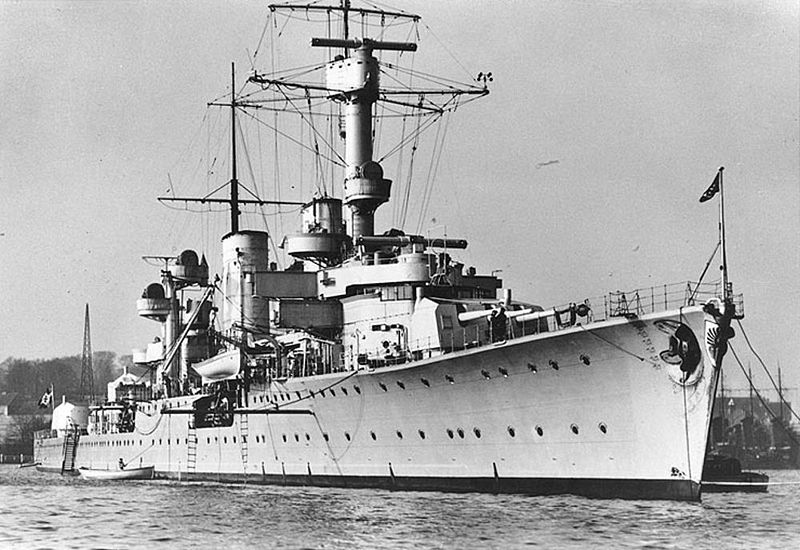
All three were used extensively as training cruisers in the 1930s, making overseas cruises, patrolling during the Spanish Civil War in 1936–1939. They laid defensive minefields in the North Sea by 1939 and saw action in Operation Weserübung by April 1940, Königsberg being damaged by coastal guns, finished off by British bombers, Karlsruhe sunk by the HMS Truant, Köln surviving. She provided gunfire support during Operation Barbarossa, and was sent in Norway in 1942, but was damaged, repatriated and eventually never fully repaired, sunk in Wilhelmshaven in March 1945. She sank even, so her guns were still above water, supporting the defense of the harbour against British forces.
 The case of the Deutschland class (1931)
The case of the Deutschland class (1931)
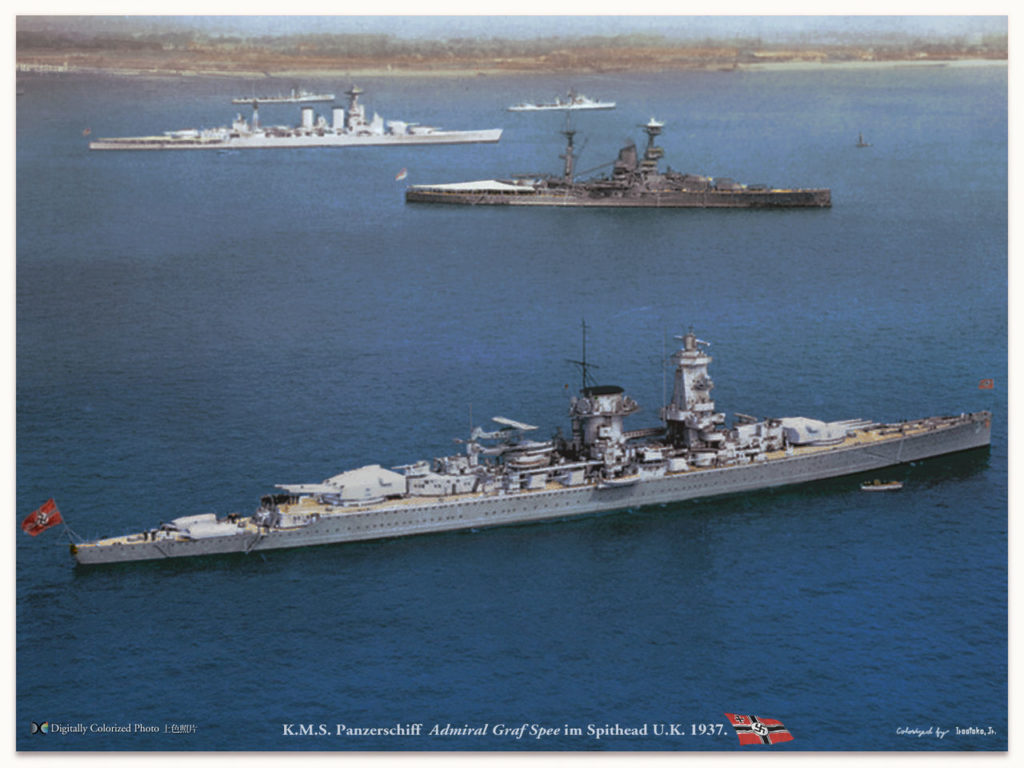
Graf Spee at the 1937 Spithead Coronation naval review – Colorized by Irootoko Jr.
The final Deutschland class post-1933 were reclassed as Panzerschiffe (armored ships), even if protection was minimal, albeit better than light cruisers:
Main turrets: 140 mm (5.5 in), Belt: 80 mm (3.1 in), Deck: 45 mm (1.8 in). It was tailored to resist 8-in (203 mm) shells, as they could only do 28 knots (52 km/h; 32 mph). Most heavy cruisers like the british County class were capable of 30-33 knots. The main armament of six 28cm main guns which outranged 8-in guns of heavy cruisers (catch: The turret were turning slow) was completed by six single 15 cm and three 8.8 cm (3.5 in) in single mounts. It was reinforced during the war quite considerably.
They patrolled during the Spanish civil war and Graf Spee was present at the 1937 Spithead coronation review. Days before WW2, Deutschland and Admiral Graf Spee were deployed preventively to the Atlantic to start preying on Allied merchant traffic at the first hours of 1st September. Admiral Scheer at the time was in maintenance. Deutschland failed in her first raiding sortie, only sinking or captured three ships. After the loss of Spee she was renamed Lützow. Admiral Graf Spee on her side had more lunck, sinking nine ships in the South Atlantic, fought at the Battle of the River Plate, and damaged, low on fuel (they had diesel engines for 10,000 nm), in poor overall condition she took refuge in Montevideo and thanks to a clever Britsh deception, sailed out to be scuttled.
Lützow and Admiral Scheer ended in Norway by 1942 after the last failure (raid of the Scharnhorst pair, of Scheer, and sinking of Bismack). Hitler in a bout of rage decided to scrap the entire surface fleet after frigin Raeder, but Kar Dönitz, formerly at the head of the U-Boat arm, convinced him to sent it instead in Norway to act as a permanent deterrent, keeping tied a large portion of the Home Fleet in Scotland, later reinforced by a part of the US Atlantic fleet. The remaining cruisers preyed on Mourmanks convoys. Admiral Scheer conducted Operation Wunderland in August 1942 in the Kara Sea. Lützow took part in the Battle of the Barents Sea in December 1942. Both were damaged and sent to Germany for repairs, which went very slowly. British bombers got them both in 1944. Lützow was raised postwar, sunk as a target by the Soviets, Admiral Scheer was BU.
Cruiser Aviation
Heinkel 60

Probably the most successful and common model of the interwar was the He 60, with 361 made, also used by Spain and Bulgaria in WW2. This sturdy biplane was operational by 1934, after a developmen tin 1932-33. They were given a liquid-cooled inline BMW VI 6.0 V-12 492 kW (660 hp) engine, but later attemps to obtained the DB 600 went to nil and when WW2 started, this model, replaced by the Arada 196, was seen as lacking power and speed. The last version, He 60D, was introduced in 1936 and production stopped in 1937. The last ones soldiered on until 1943.
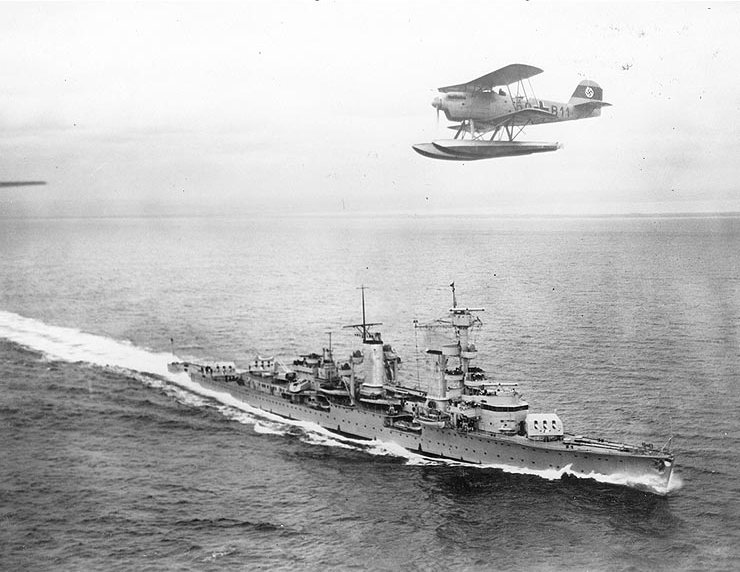
He 60 over KMS Köln (K class). They were shared by the three K class, as well as Leipzig, Nürnberg, the three Deustchland class practically until WW2 started, possibly also briefly by KMS Hipper after completion, and the two Scharnhorst class.
Heinkel 114

A rather modern parasol monoplane floatplane, the He 114 (1936) had some structural weakness and was never accepted on Kriegsmarine’s “cruisers” per se, but auxilary cruisers (Hilfskreuzer): The Atlantis, Widder, and Pinguin. See the page on the He 114.
Arado 196
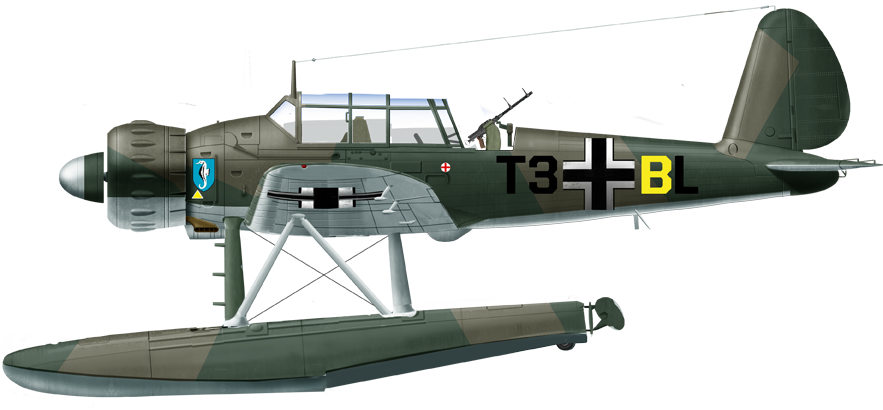
Arado 196A3 of Bdflgr Prinz Eugen, 1941
The A196 was probably one of the most famous model of the company as far as naval aviation is concerned. The Ar 196 was designed to replace the mediocre He 114, as asked by the Reichsluftfahrtministerium, it was designed by Walter Blume it first flew in 1937, and started service in 1938-39, wit 541 deliveries until August 1944. First monoplane floatplane, it became the standard WW2 shipboard reconnaissance and observation model of the Kriegsmarine, used on the two Birmarck class, the three Hipper class ships, and replacing the He 60 on the three surviving Deutschland but not Graf Spee which used well it until her demise. The A196 also was found on the remaining light cruisers also until their loss, and the Hilfskreuzer that had floatplanes aboard in 1942-43. Outside ships it was used on numerous coastal squadrons, from Norway to the Mediterranean until late 1944 and their most famous action was the capture of the British minelayer sub HMS Seal. Bulgaria also used and many were captured by the Allies, France used its own in Indochina until 1955.
More on the Luftwaffe and Kriegsmarine
Kriegsmarine’s cruisers and Plan Z
PLAN Z for cruisers included the following. The Panzerschiffe in their new design were decidedly too large and well armoured by tonnage to be considered as part of the cruisers and are not included here.
Heavy cruisers (Schwere Kreuzer): 5 planned, 3 built.
Light cruisers (Leichte Kreuzer): 13 planned, 6 built.
Scout cruisers (Spähkreuzer): 22 planned, none built.
We are going to see the ships built, and projects at the end.
 Leichtes Kreuzer Leipzig class (1936)
Leichtes Kreuzer Leipzig class (1936)
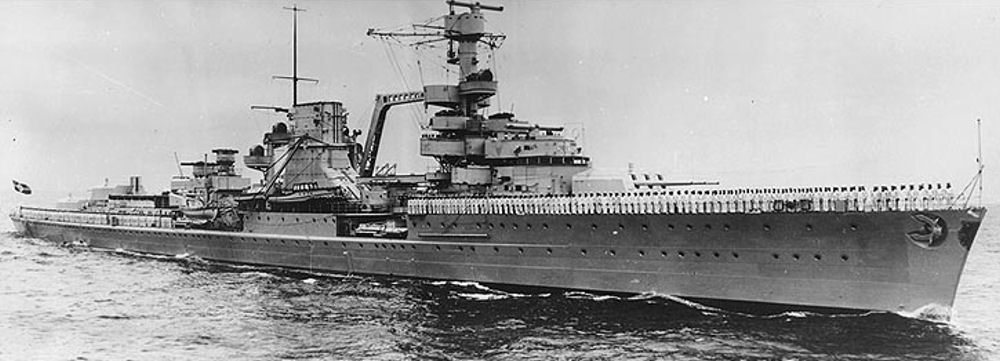
Design of the last German light cruiser class
Started in 1927 on behalf of the Reichsmarine in Whilelmshaven, the Leipzig was an improved version of the previous “K” class, while keeping the essential, but also the flaws. The main part of its structure, especially the hull, was persevered, resulting in structural weaknesses and a “limiting” stability of the width of the hull. The chimneys were grouped together in a single structure, and the superstructure of the forecastle prolonged, the triple turrets rearranged in the axis, and the bow of “classical” again, for a longer length and an increased width. The Nuremberg, on the other hand, was attacked for the Kriegsmarine, and the frontiers of the Treaty of Versailles were freed. It resulted in an increase in size, protection, and weight… Moreover its bridge superstructure was revised, more massive and better protected. His diesels were a new, more economical model. At the end of Nürnberg was the only really successful cruiser of this series of “Leichte Kreuzer”.
The Leipzig class in action
Before the conflict, the two ships participated in the naval blockade of arms to Spain (1936-39). At the time of the war, Leipzig was involved in mine clearance operations off the coast of England when it was torpedoed by British submarine HMS Salmon, along with its “twin”, the Nürnberg. The Leipzig returned to Germany and was converted into a training vessel, in particular two boilers were replaced to make chambers and its speed had fallen to 27 knots.
She returned to service on the occasion of Operation Barbarossa (June 1941), bombing Russian advanced bases in the Baltic. He then remained in the Baltic for training, and entered during an outing in foggy weather in collision with the Prinz Eugen. Repaired, but suffering from problems, he was less and less active. In 1945, he was serving as a dock ship and DCA support at Whilelmshaven. Then he operated off Gdynia to try to slow down the Russian lead. He eventually surrendered to the British. It was scuttled in the North Sea in 1946.
The Nuremberg, on the other hand, also torpedoed by the Salmon when she was laying mines, missed operations in Norway. However, she sailed to a fjord for operations against the convoys of the great north, and alternated these missions with those in the Baltic. She eventually surrendered to the allies in Copenhagen in 1945 and was attributed to the USSR as a war-warrant, renamed Admiral Makharov. She retired from service in 1959, the only surviving German cruiser.

KMS Leipzig

KMS Nürnberg
KMS Nürnberg specifications
Dimensions: 177 x 16.30 x 5.65 m
Displacement: 6200 t/8380 tonnes FL
Crew: 1150
Propulsion: 2 shafts, Brown-Boveri turbines, 66,000 hp, 2 MAN diesels 12 400 hp
Speed: 32/19 knots (xx km/h; xx mph) Radius 5700 Nautical Miles
Armament: 9(3×3)x 152 mm, 6x 88 mm AA, 8x 37mm AA, 12(4×3) TT 533 mm, 120 mines, 2 planes
Armor: Belt: 30 mm (), Deck: 25 mm (), Turrets 30mm, Conning tower: 30 mm ()
 Schwere Kreuzer Hipper class (1937)
Schwere Kreuzer Hipper class (1937)
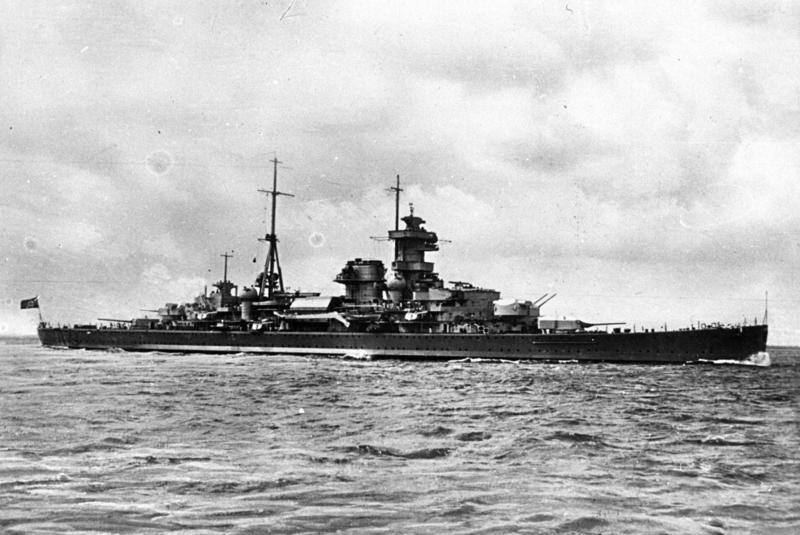
The Hipper class comprised the first (and last) five German Navy heavy cruisers, of which only three were completed. The fourth, named Seydlitz, was suspended and later to be converted into an aircraft carrier. The fifth, Lützow, was sold half-finished to the Soviet Union in 1940 and never completed either.
The German-British Naval Agreement granted Germany a total of five heavy cruisers and Blücher, Admiral Hipper, Prinz Eugen were planned unless special circumstances made it necessary to build two more, which was confirmed on June 8, 1936 by Erich Raeder, cruisers “K” and “L” with an initial main armament or triple turrets and 15 cm guns in four triple turrets. However Adolf Hitler soon ordered their reconversion as heavy cruisers. Their career is described below.
Hipper class specifications
Dimensions: 209 x 20.30 x 7.3 m
Displacement: 16,000 t/18,000 tonnes FL
Crew: 1,150
Propulsion: 4 shafts, 4 turbines, 12 boilers, 320,000 bhp
Speed: 32 knots Radius 9,000 Nautical Miles
Armament: 4×2 203 (8-in) mm, 6×2 105 (4-in) mm AA, 6×2 37mm AA, 8×1 20mm AA, 4×3 TT 533 mm (21-in), mines, 3-4 planes
Armor: Belt: 80 mm, Deck: 30 mm, Turrets 100mm, Conning tower: 150 mm
 KMS Hipper
KMS Hipper

Hipper made two raid cruises in 1939, totaling 60,000 tons of merchant vessels. She took part in the Norwegian campaign (Weserübung), and off Trondheim badly damaged the destroyer HMS Glowworm. The latter managed however to maneuver just before sinking, ramming the Hipper, which left a deep hull depression and significant internal damage. However, this did not prevented Hipper’s landing party to erect the Nazi flag on Kristiansand, taking all the city’s organs (Telecommunication, energy, etc.) without the inhabitants noticing. The Hipper than departed and patrolled along the Norwegian coast accompanied by the battleships Scharnhorst and Gneisenau, then returned to Kiel for repair.
Two new raids in the Atlantic has been later canceled due to turbine failures. From December she returned to the Atlantic, undetected, and from Brest, made some sorties against British trade, notably against convoy WS-5A in December 1940 and SLS64 in February 1941. She then joined Kiel for minor improvements and the addition of additional oil tanks, and returned to Norway. She remained there to operate against the Arctic convoys. She was severely damaged during an attack of one of These convoys in December 1942. After returning to Wilhelmshaven for repair, she remained there, set aside by Hitler’s order, completely disillusioned with surface ships. In January 1945 her partial repairs served her to evacuate civilians and troops from the ports of East Prussia, from the fury of the Russian troops (Operation Hannibal). She was broken up in Kiel in May 1945.
 KMS Blücher
KMS Blücher
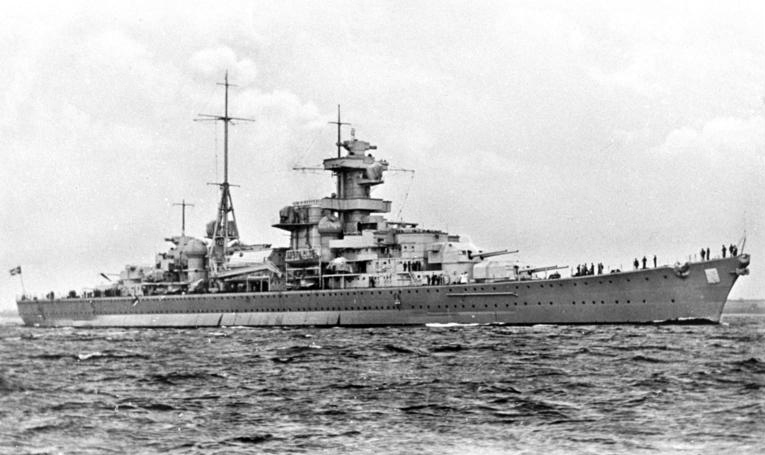
The Blücher had a power plant slightly different from its twin, but unchanged speed. She took part in the attack on Norway (Weserübung), as flagship of naval group 5 (including Lützow, Emden, three torpedo boats and 8 minesweepers under Oskar Kummetz), intended to land troops and men of the Gestapo destined to take organs of communication and power in Oslo. As she advanced by night in the fjord, her weapons remained perfectly aligned in a gesture of disdain against Norwegian fortifications, but she was nevertheless surprised by the patrol boat Pol III just before midnight. The latter raised the alarm, and Oscarborg battery’s gunners, although inexperienced and having only old 280 mm Krupp guns dating back from 1890, fired at 1600-1800 meters, seriously damaging the cruiser, who then could not reply. As a result, this first blood was followed by practically firing pieces of the coast, even minor ones.
Blücher was rapidly in flames, and sunk later at point-blank range by the Dröbak fjord batteries, 280 mm from Oscarborg and 150 mm from the Kopas battery, completed by torpedoes from Kaholm fort (old Austro-Hungarian Whitehead models from 1895). Nevertheless, and despite the icy waters, there were few victims, the banks being close. During the same event, the pocket battleship Lützow (former Deutschland) was also severely damaged and had to retreat. Oslo was saved, allowing the Royal family to leave the country. The Blücher still lies at 90 meters in the middle of the fjord, an attraction for divers. In 1994 an operation was carried out to extract the oil escaping from its rusting tanks. That gave an opportunity to retrieve an anchor, now exposed to Aker Brygge, and an Arado seaplane, now exposed in Stavanger Museum.
 KMS Prinz Eugen
KMS Prinz Eugen
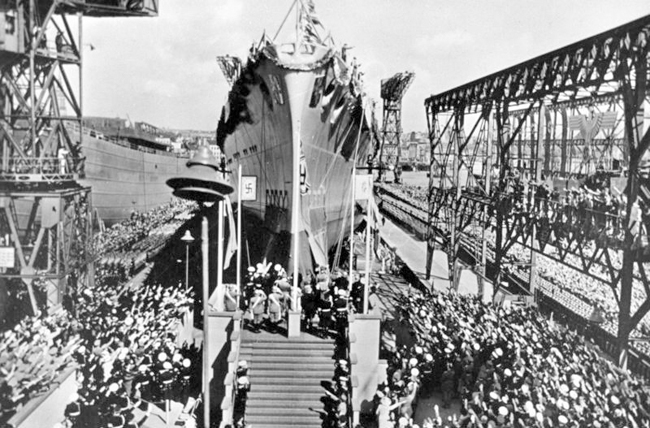
KMS Prinz Eugen launch at Kiel, 22 August 1938
KMS Prinz Eugen, named after Prince Eugene of Savoy (in honor of the Austrian part of the new third Reich) was nicknamed the “lucky”. Launched in 1938, her construction costed at the tome some 104 million Reichsmarks. She was to participate in the operations in Norway but was not yet ready for service. On 2 July 1940 she was attacked and damaged by the RAF. On 23 April 1941 after substantial repairs, she was again put out of action by a magnetic mine. On 24 May, 1941 she was ready for Operation Rheinübung in the company of Bismarck.
This was her most famous action. Opening fire against the Hood, at maximum angle, it is very possible that her shells set fire to the rear boats deck (spreading into more vital parts of the ship, that blew her up). Then she was ordered to concentrate fire on the HMS Prince of Wales (which the Germans had taken for HMS King George V), scoring four hits. When the Bismarck was defeated, PE had to divert to France, to continue her mission against British trade.
On her first sortie she was to find the tanker Spichern, but turned back on 29 May because of turbine failures. Anchored in Brest, she was the target of constant attacks by the RAF. On the night of July, 1st, she was severely damaged by a bomb hitting the rear artillery control center, killing 60. On 11-12 February after repair, she escorted the Scharnhorst and Gneisenau through the channel, to the Baltic (operation Cerberus) with success. In February she went back to Trondheim Fjord.
In another raid she was torpedoed by HMS Trident, lost her stern and remained almost a year in repair at Kiel, only back into service in January 1943. Because of her troublesome turbines however she could not join Norway and spent the remainder of her service time in the Baltic, as an escort vessel and training ship. From October 1944 she assisted troops in East Prussia with her artillery, and later helped to evacuate troops and civilians during the siege of Danzig in 1945. On October 15, by foggy weather, she collided with the KMS Leipzig, and was sent to Gdynia (Gotenhafen) for repairs. After a final evacuation, she went to Copenhagen on 20 April.
KMS Prinz Eugen remained in Denmark due to lack of fuel. She was captured by the British on May 8, and after the war was attributed to the US Navy, renamed USS Prinz Eugen/IX300, and thoroughly examined by engineers. Her sonar was recovered and tested on a submersible, her magnetic amplifiers were reverse-engineered. She was eventually sent into the Pacific, through the Panama Canal. Stationed in the Bikini atoll for Operation Crossroads, she was badly irradiated by two nuclear explosions (tests Abel and Baker).
In September 1946, he was towed and sunk in the Kwajalein atoll where she remains. Her bell is currently exposed in the Washington DC Museum, and her propeller was repatriated in 1978, and is currently exposed in Laboe, Germany.
 KMS Seydlitz
KMS Seydlitz
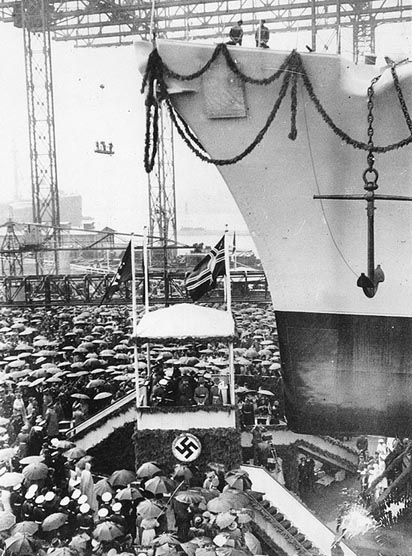
KMS Seydlitz being launched
Both heavy cruisers were sister-ships of the Prinz Eugen, larger than the first Hipper. They were built at the Deutsche Schiff und Maschinenbau of Bremen, laid down in 29 December 1936 and 2 August 1937, launched in January and August 1939.
Seydlitz‘s construction was approximately 95 percent complete when halted. In March 1942 it was decided to convert her into an aircraft carrier. She was renamed Weser, and conversion work began in May 1942: All superstructures were erased (about 2400 tons), and a hangar was started, which could have housed ten Bf 109 fighters and ten Ju 87 dive-bombers.
AA artillery was to comprise 10x 10.5 cm SK C/33 guns in dual mounts, 10x 3.7 cm SK C/30 guns also in dual mounts, plus 24x 2 cm Flak 38 guns in quad-mounts. Work was halted again in June 1943, she was towed to Königsberg and stayed there unfinished, only to be scuttled in January 1945. Briefly seized by the advancing Soviet Army she was later sold for scrap.
 KMS Lützow
KMS Lützow
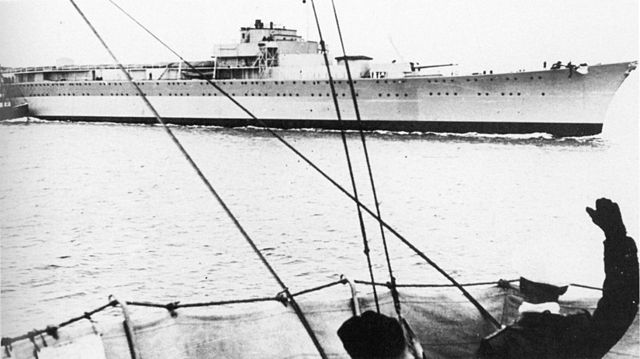
Unfinished Lützow being transferred to USSR, 1940
The Lützow was the object of intense negotiations between the 3rd Reich and the USSR from October 1939 to February 1940, that thought to acquire her. Concluded, the transfer took place in April, but then she lacked half her battery and most of ther superstructure was missing. renamed Petropavlovsk she was to be completed by a German-advised Soviet shipyard in Leningrad. After Operation Barbarossa began of course all was halted, and the ship took part in the defense of Leningrad, before being silenced by German heavy artillery.
Sunk, then raised again in September 1942 she was repaired as Tallinn, and took part in the operations for taking back the city in 1944. After the war she served as floating barracks until broken up from 1953.
Z-Plan cruiser projects
 M class (1939)
M class (1939)
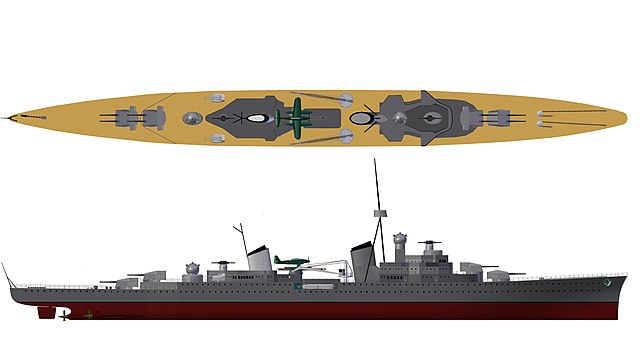
The early M class was just a slightly larger Leipzig class, so still armed with three triple 6-in guns turrets, light armour, good speed but limited range. Tailored for commerce raiding in the Atlantic, their designs suffered from a number of problems, leading to the 5th and 6th being substantially redesigned:
The first four M-class ships (M, N, O, P) measured 183 m (600 ft 5 in) long overall, whereas the Q and R reached 196 m (643 ft 1 in) overall while being larger for 9500 tonnes standard. They had two catapults for more reconnaissance range. The armament
The name of the class is taken from the letter designating the first projected unit. As long as the ships were not named, they were referred to by letters assigned in the chronological order of their planned construction. The first planned unit would have been the thirteenth German cruiser and was therefore listed as cruiser M in the navy’s documents. Had any of the ships been built, the class would have been named after the first completed unit.
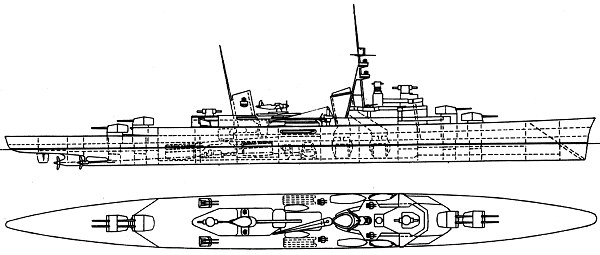
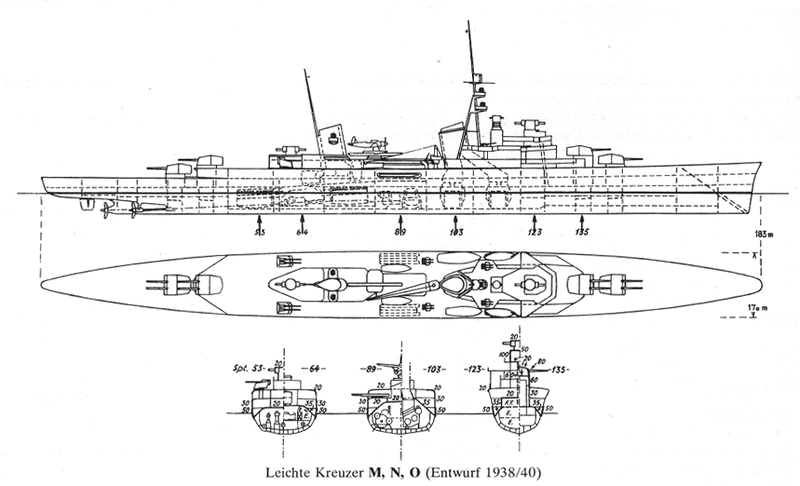
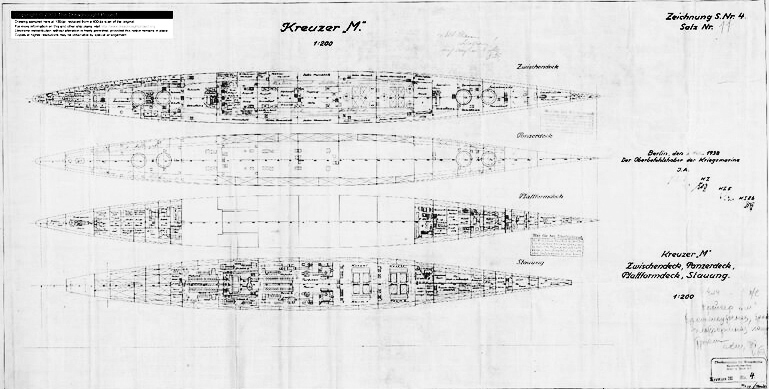
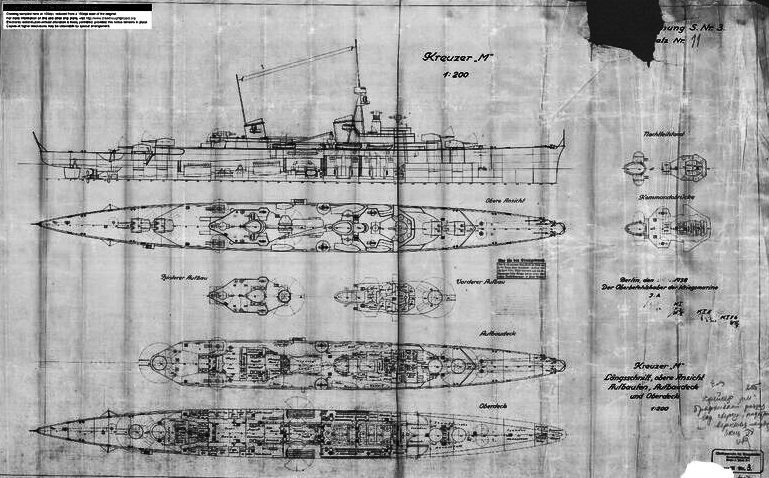

Due to still extant plans, the M class is probably the best known of these unbuilt projects and likely our first project in 2024.
M class specifications (*Q,R)
Dimensions: 183 m/196 m* (600 ft/643 ft*) x 17/18* m x 5.42/5.40* m
Displacement: 8,500 t (M-P) to 9,300 t (Q, R*) standard
Crew: 28 officers +892 ratings
Propulsion: 2 steam turbines, 4 diesels, 4 water-tube boilers
Speed: 35.5/36 knots* (67 km/h; 41 mph)
Range: 8,000 nmi/12,000 nmi* (22,000 km) at 19 knots
Armament: 4×2 15 cm (5.9 in), 4× 8.8 cm AA, 8× 3.7 cm AA, 4× 2 cm AA, 2×4 53 cm TTs, 60 mines
Air Park: 1 axial catapult, 2 Arado 196 seaplanes
Armor: Belt: 2 in (51 mm), Deck: 1 in (25 mm), Turrets: 1 in (25 mm)
 D class heavy cruisers
D class heavy cruisers
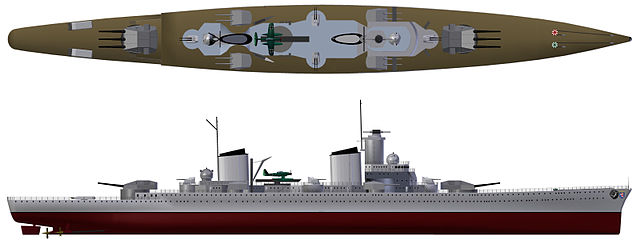
“Ersatz Hessen”, laid down on 14 February 1934 as “D”.
Although classed in western literrature as heavy cruisers (or “large cruisers” akin the US Alaska class of 1943), in German documentation they were called “panzerschiffe”, which is deceiptive since they were not armoured as capital ships but rather like cruisers, but they sported 28 cm guns (or 21 cm in previous projects).
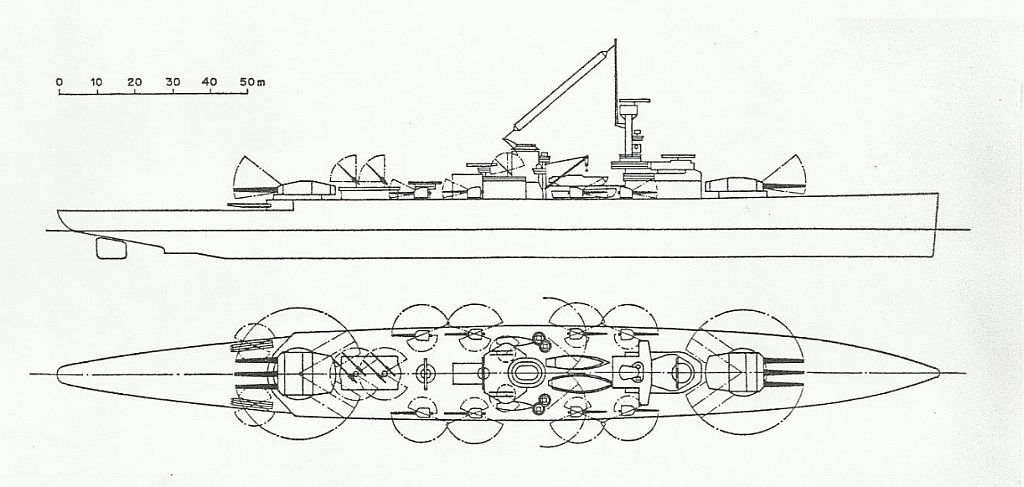
A projected successor of the Deustchland class
In 1933, the Reichsmarine was authorized to look for much improved successors of the Deutschland-class cruisers, to counter a new French naval construction program. Displacement went straight out of Versailles limits at 20,000 long tons (20,321 t), and Hitler personally forbade a better battery and only improvements in range and protection. Only one of two planned were laid down, “D” on 14 February 1934 but Work was halted on 5 July 1934, as she canceled less than 5 months after, and she was broken up to clear the slipway. In between it was estimated that the arrival of the new French Dunkerque-class ships, necessitated a third triple turret and the project evolved in the Scharnhorst-class battleships. They were provisionally planned as “D” and “E”.
Specifications
Displacement: 20,000 long tons (20,000 t) standard
Dimensions: 230 m (754 ft 7 in) overall x 25.5 m (83 ft 8 in) x 8.5 m (27 ft 11 in)
Propulsion: 2 steam turbines, likely 4 diesels, 125,000 PS (123,000 shp) for 29 knots (54 km/h; 33 mph)
Armament: 2×3 28 cm/52 SK C/28, 4×2 15 cm/55 SK C/28, 4×2 10.5 cm/65 SK C/33 AA guns.
Armor: Belt 220 mm (8.7 in), upper deck 35 mm (1.4 in), deck 70 to 80 mm (2.8 to 3.1 in), turrets:200 to 360 mm (7.9 to 14.2 in), CT 300 mm (12 in), Citadel: 50 mm (2 in)
 P class heavy cruisers
P class heavy cruisers
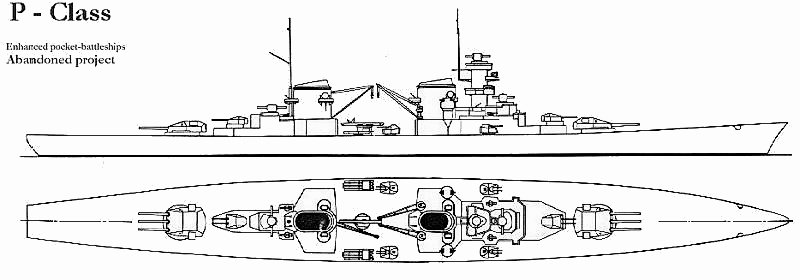
The P class were larger Panzerschiffe intended notably to deal with the French Dunkerque class and commerce raiding after the cancelled D-class. It was to have comprised twelve ships authorized in 1937. Design work went on until 1939 after 9 designs considered. The one retained had six 28 cm (11 in) QF guns in two triple turrets like for the D-class and Deutschland class. Named P1–P12, they were heavier and faster and went back to full diesel propulsion for greater range, including in Plan Z as submitted by the Navy, and a key feature in Grand Admiral Erich Raeder’s plans for a large scale commerce warfare against the British Empire. The plan was revised down to 8 ships, until cancellation on 27 July 1939 before any work started and instead three O-class battlecruisers ordered. The O-class were never built either.
Specifications
Displacement: 22,145 t standard, 25,689 t (25,283 long tons) FL
Dimensions: 230 m (754 ft 7 in) oa x 26 m (85 ft 4 in) x 7.20 m (23 ft 7 in)
Propulsion: 12 Diesel engines, 165,000 PS (163,000 shp), 33 knots (61 km/h; 38 mph)
Range: 25,000 nmi (46,000 km; 29,000 mi) at 13 knots (24 km/h; 15 mph)
Armament: 3×3 28 cm (11 in), 4× 15 cm, 4× 10.5 cm, 4× 3.7 cm AA guns 2×3 53.3 cm TTs
Armor: Barbettes: 80-100, Belt 40-120, Deck 70, Torpedo bulkhead 30 mm
Aviation: 2 steam catapults, 2× Arado 196 seaplanes
 Krupp 1939 heavy cruisers
Krupp 1939 heavy cruisers

At first, the pre-hipper class project was that of two lighter cruisers tailored for commerce raiding, to be named seydlitz and Lutzow, each with three, and later four triple 6-in guns and two catapults. It was then plan to convert them as heavy cruisers from 1936, with 8-in guns. The Krupp Consortium also developed the three-gun turret SK L/56 for the same guns SK C/34 used on Admiral Hipper-class ships, for an upgraded class escorting the new P-class battleships. They would have sported twelve guns.
 Schichau light cruisers (1928)
Schichau light cruisers (1928)

Light cruiser “Berlin”, with five twin 5.9″ C28 gun turrets, allegedly a 1928 naval plan proposal by Schichau yards.
 Spähkreuzer
Spähkreuzer
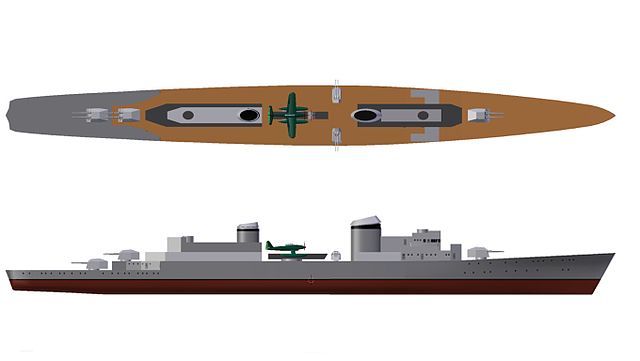
Development history: At the beginning of 1937, the Naval Construction Office proposed a project of large destroyer which was rejected. This triggered a development that resulted in a ship for Atlantic use. This was supposed to be superior in armament to fleet destroyers and be able to outrun enemy cruisers. Tasks were to scout and screen heavier units operating individually or in formation as part of oceanic naval warfare, support heavy units in tactical cruiser warfare, and convoy security or Independent use for commerce warfare.
The first clearly defined design was called Scout Cruiser 38. This was a design with two funnels displacing 6,000 tons. In addition to three twin turrets with standard 15 cm forward as for the K class (1 forward, 2 aft) and two quintuple TT banks, they had an hybrid powerplant with steam turbine and diesels for 77,500 WHP + 14,500 HP and 35 knots. Protection was limited to the essential, deck 15 mm, longit. bulkhead 18 mm and 12 mm for other critical areas.
Changes led to scout cruiser 39, which had increased dimensions at 7,550 tons standard, the extra lenght used to add better anti-aircraft complement and armour protection, an on-board aircraft, but at the price of a speed loss of three knots. They would have a 50 mm thick belt, 25 mm for deck armor, 12 mm for the inner longitudinal bulkhead. They had two funnels, redesigned superstructures, and a catapult instead of torpedo tubes between funnels.
The final design, Scout Cruiser 40, was even larger as the admiralty wanted a larger powerplant to regain top speed, and the turrets were shifted around, two forward and one aft. The torpedo tubes return, and the catapult was deleted. It had a greater speed and even a 50% larger radius of action, better AA now close to a standard light cruiser.
In February 1939, with Z-Plan, the Naval War Command emphasised the role of scout cruisers for their intended warfare, but arbitrations were needed as it came at odds with the rest of the shipbuilding program. Nevertheless, on February 17, 1941, a construction order for three (Spähkreuzer 40) were placed to Germania shipyard, Kiel, named provisionally 671, 672 and 673 and to be commissioned as Z40, E41 and Z42 or SP 1 to SP 3. The contract for the main propulsion system for the next three ships, SP 4 to SP 6 was awarded already in December 1941, but construction work was stopped by April 1942, and cancelled as Dönitz redirected shipyard capacity and material to U-Boat construction. They would remain an interesting “whatif”, to compare not with the British Cossak or French Mogador but rather to the British Dido, Italian Capitani Romani, Japanese Agano and Dutch Tromp.
 Minenleger Kreuzer
Minenleger Kreuzer
The German Kriegsmarine had no dedicated minelayer cruiser when WW2 broke out, and minelaying operations were done at first by light cruisers, and and then by destroyers and torpedo boats, with dedicated minenleger U-Boat or “U-minen” were built in short numbers. The Kriegsmarine thus has many captured civilian ships modified for mine laying. After the invasion of Norway, the captured Norwegian minelayer Olav Trayggvason (renamed Albatros, later Brummer) became the one and only dedicated minelayer in service.
In 1937 however four cruisers minelayers was planned, ordered in July 1938, May 1939 in two batches, with completion projected by the summer of summer 1941. But yard space was lacking and construction was not even started before being cancelled in October 1939.
These looked like taller destroyers, about 130m in lenght with a long forecastle, low superstructures, one funnel, two masts or unequal size, and armed only by four superfiring 10.5 SKL guns. Mines were stored internally with chutes aft of the deck. Basically an entire deck was freed to make space for mines on four tracks in “U”. This large space was enabled for troop transport as well. This allowed setup of the mines in enclosed space, spared water spray. Mines could also be loaded via two doors port and starboard.
Read More/Src
Books
Hans Zenker’s warship designs in the Tambach archives: ‘The Zenker documents, Reichmarine naval constructions 1919 -1933’
Bidlingmaier, Gerhard (1971). “KM Admiral Graf Spee”. Warship Profile 4. Windsor: Profile Publications.
Budzbon, Przemyslaw (1992). “Soviet Union”. In Gardiner, Robert; Chesneau, Roger (eds.). Conway’s All the World’s Fighting Ships 1922–1946
Gröner, Erich (1990). German Warships: 1815–1945. Vol. I: Major Surface Vessels. NIP
Haar, Geir H. (2009). The German invasion of Norway – April 1940. Barnsley: Seaforth Publishing. ISBN 978-1-84832-032-1.
Hümmelchen, Gerhard (1976). Die Deutschen Seeflieger 1935–1945 (in German). Munich: Lehmann.
Philbin, Tobias R. (1994). The Lure of Neptune: German-Soviet Naval Collaboration and Ambitions, 1919–1941.
Williamson, Gordon (2003). German Heavy Cruisers 1939–1945. Oxford: Osprey Publishing.
Williamson, Gordon (2003). German Pocket Battleships 1939–1945. Oxford: Osprey Publishing.
Links
navypedia.org german cruisers
navypedia.org niobe
Gazelle-class_cruiser
http://wargamingmiscellany.blogspot.com/2017/06/german-flakschiff-arcona-and-medusa.html
https://en.wikipedia.org/wiki/List_of_heavy_cruisers_of_Germany
https://www.berliner-dampfer.de/html/1902_kreuzer.html
https://www.german-navy.de/hochseeflotte/ships/smallcruiser/berlin/index.html
https://www.german-navy.de/hochseeflotte/ships/smallcruiser/kreuzer1916/index.html
https://www.german-navy.de/kriegsmarine/ships/index.html
https://www.german-navy.de/kriegsmarine/ships/heavycruiser/lutzow/index.html
https://www.german-navy.de/kriegsmarine/ships/minelayer/minelayer/index.html
https://www.german-navy.de/kriegsmarine/ships/destroyer/spahkreuzer/index.html
https://uboatarchive.net/BDU/BDUKTBNARA.htm
http://www.avalanchepress.com/WeimarFleet.php?mode=print
https://www.tapatalk.com/groups/warships1discussionboards/admiral-zenker-s-warship-design-s-t21297.html
https://forum.worldofwarships.eu/index.php?/topic/4789-
https://medium.com/@wows_historians/paper-ships-cruiser-hindenburg-a98d3914c759
https://www.history.navy.mil/research/archives/Collections/transferred-collections/nara-transfer/german-naval-archives.html
Videos
German interwar cruiser procurement By Dr. Alex Clarke


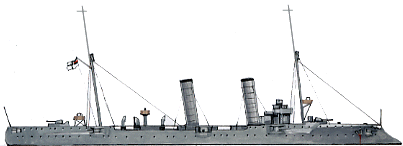
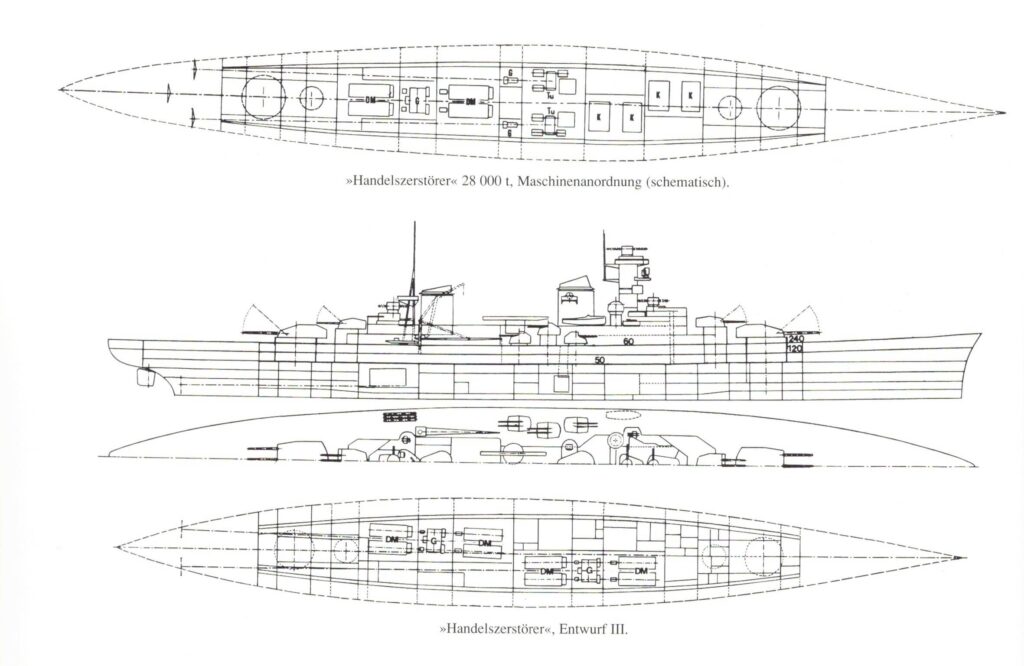
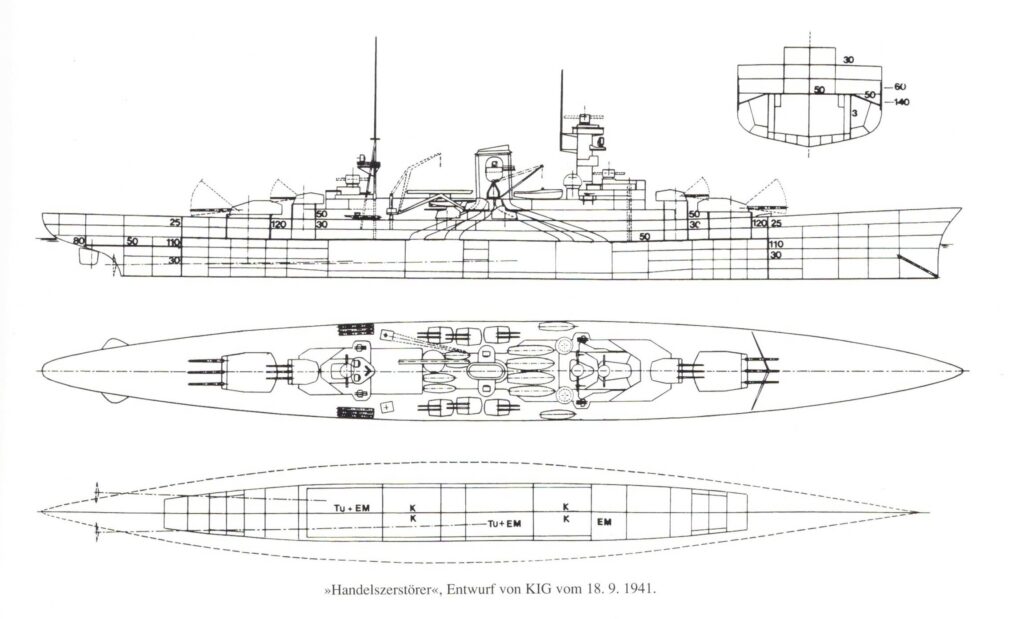
 Latest Facebook Entry -
Latest Facebook Entry -  X(Tweeter) Naval Encyclopedia's deck archive
X(Tweeter) Naval Encyclopedia's deck archive Instagram (@navalencyc)
Instagram (@navalencyc)





 French Navy
French Navy Royal Navy
Royal Navy Russian Navy
Russian Navy Armada Espanola
Armada Espanola Austrian Navy
Austrian Navy K.u.K. Kriegsmarine
K.u.K. Kriegsmarine Dansk Marine
Dansk Marine Nautiko Hellenon
Nautiko Hellenon Koninklije Marine 1870
Koninklije Marine 1870 Marinha do Brasil
Marinha do Brasil Osmanlı Donanması
Osmanlı Donanması Marina Do Peru
Marina Do Peru Marinha do Portugal
Marinha do Portugal Regia Marina 1870
Regia Marina 1870 Nihhon Kaigun 1870
Nihhon Kaigun 1870 Preußische Marine 1870
Preußische Marine 1870 Russkiy Flot 1870
Russkiy Flot 1870 Svenska marinen
Svenska marinen Søværnet
Søværnet Union Navy
Union Navy Confederate Navy
Confederate Navy Armada de Argentina
Armada de Argentina Imperial Chinese Navy
Imperial Chinese Navy Marinha do Portugal
Marinha do Portugal Mexico
Mexico Kaiserliche Marine
Kaiserliche Marine 1898 US Navy
1898 US Navy Sovietskiy Flot
Sovietskiy Flot Royal Canadian Navy
Royal Canadian Navy Royal Australian Navy
Royal Australian Navy RNZN Fleet
RNZN Fleet Chinese Navy 1937
Chinese Navy 1937 Kriegsmarine
Kriegsmarine Chilean Navy
Chilean Navy Danish Navy
Danish Navy Finnish Navy
Finnish Navy Hellenic Navy
Hellenic Navy Polish Navy
Polish Navy Romanian Navy
Romanian Navy Turkish Navy
Turkish Navy Royal Yugoslav Navy
Royal Yugoslav Navy Royal Thai Navy
Royal Thai Navy Minor Navies
Minor Navies Albania
Albania Austria
Austria Belgium
Belgium Columbia
Columbia Costa Rica
Costa Rica Cuba
Cuba Czechoslovakia
Czechoslovakia Dominican Republic
Dominican Republic Haiti
Haiti Hungary
Hungary Honduras
Honduras Estonia
Estonia Iceland
Iceland Eire
Eire Equador
Equador Iran
Iran Iraq
Iraq Latvia
Latvia Liberia
Liberia Lithuania
Lithuania Mandchukuo
Mandchukuo Morocco
Morocco Nicaragua
Nicaragua Persia
Persia San Salvador
San Salvador Sarawak
Sarawak Uruguay
Uruguay Venezuela
Venezuela Zanzibar
Zanzibar Warsaw Pact Navies
Warsaw Pact Navies Bulgaria
Bulgaria Hungary
Hungary

 Bundesmarine
Bundesmarine Dutch Navy
Dutch Navy Hellenic Navy
Hellenic Navy Marina Militare
Marina Militare Yugoslav Navy
Yugoslav Navy Chinese Navy
Chinese Navy Indian Navy
Indian Navy Indonesian Navy
Indonesian Navy JMSDF
JMSDF North Korean Navy
North Korean Navy Pakistani Navy
Pakistani Navy Philippines Navy
Philippines Navy ROKN
ROKN Rep. of Singapore Navy
Rep. of Singapore Navy Taiwanese Navy
Taiwanese Navy IDF Navy
IDF Navy Saudi Navy
Saudi Navy Royal New Zealand Navy
Royal New Zealand Navy Egyptian Navy
Egyptian Navy South African Navy
South African Navy






























 Ukrainian Navy
Ukrainian Navy dbodesign
dbodesign
Hipper class specifications is not 152 mm but 203 mm
Hi Jan L, true, fixed, thx for spotting !